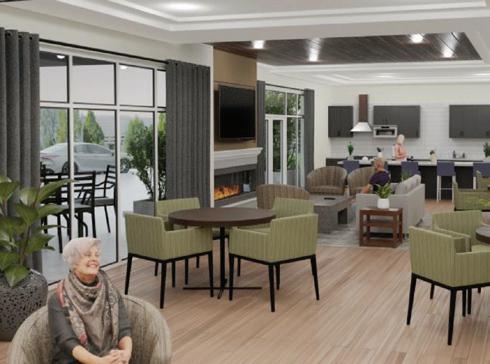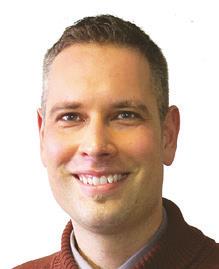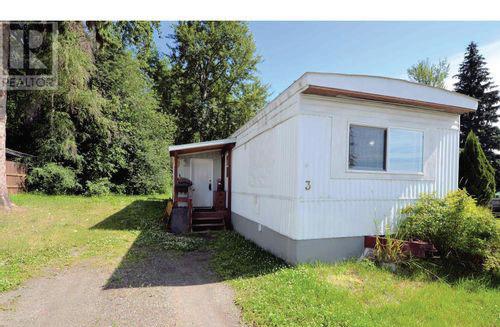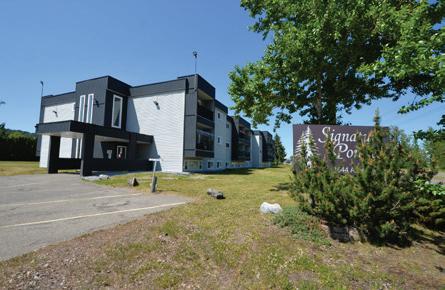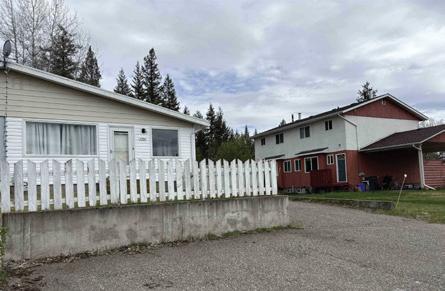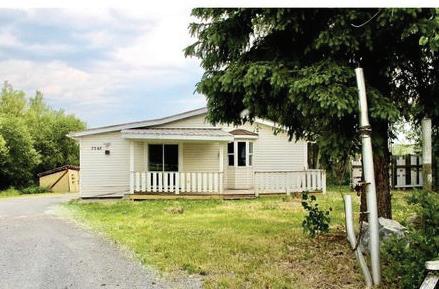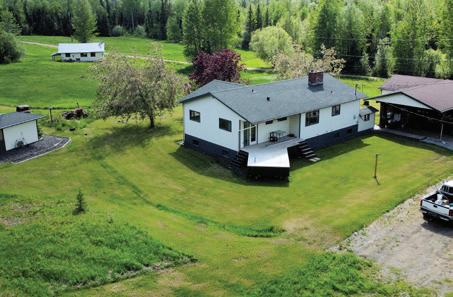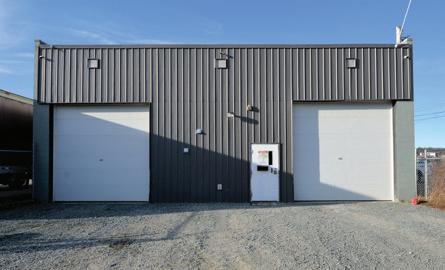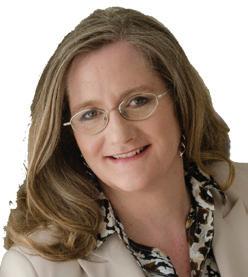



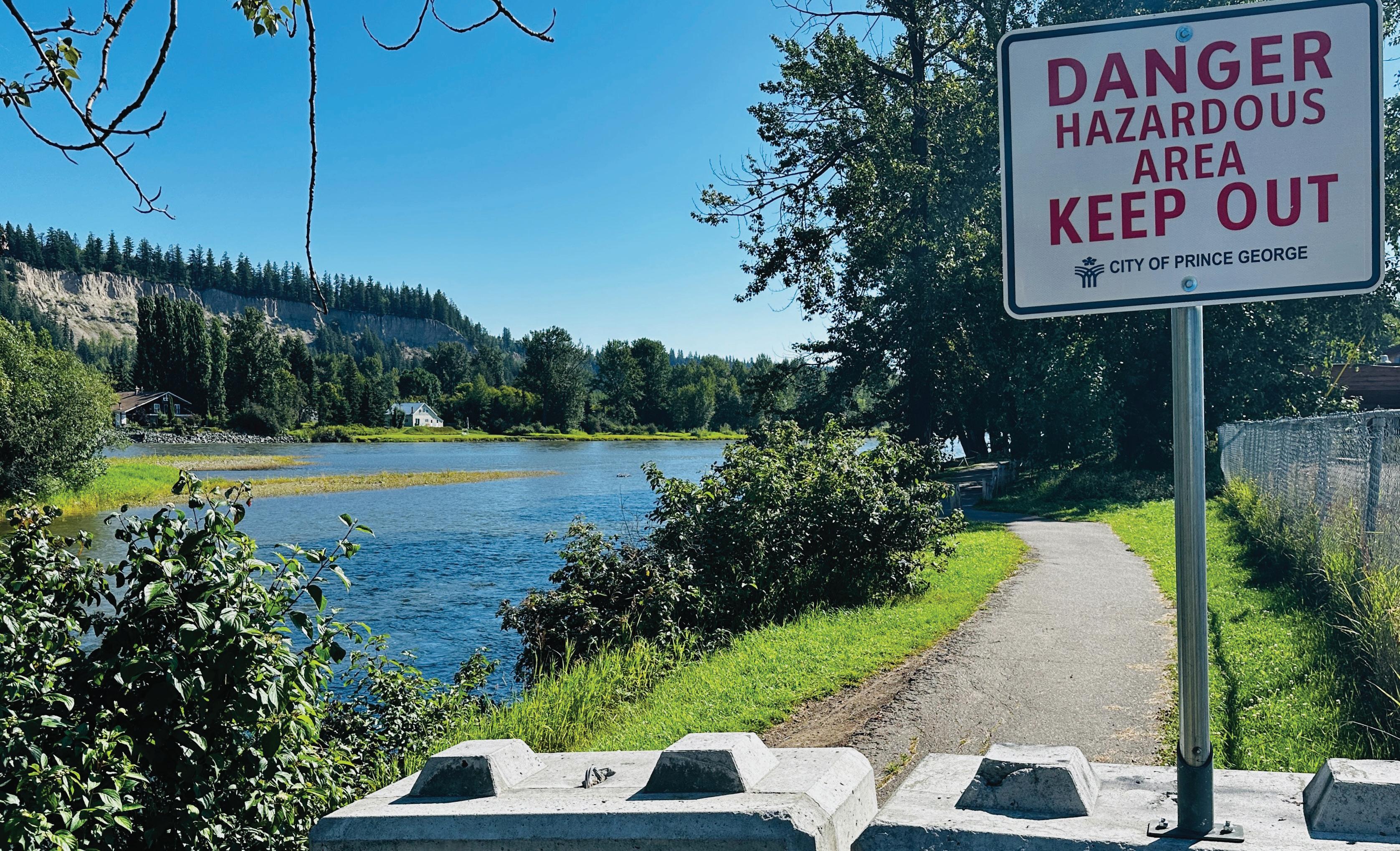








The city wants to x the problem, but there are environmental concerns to be dealt with rst
Staff
The nine-kilometre trail that runs from the Cameron Street Bridge, through Cottonwood Island Park, Lheidli T’enneh Memorial Park, Hudson’s Bay Wetland and finally to Carrie Jane Gray Park known collectively as the Heritage River Trail has seen better days.
The parts of the trail along the Fraser and Nechako rivers, especially the Nechako, are most affected by erosion.
Sections are blocked off by concrete dividers.
Those who climb over are liable to run into areas where only narrow strips of trail are left, with the rest having crumbled and slid down to the water.
Trail users The Citizen spoke to expressed a desire for the pathways to be returned to their former glory, but representatives from the City of Prince George and Spruce City Wildlife Association said that protections for an endangered species of fish put major constraints on what work they’re able to do.
Jeremy Solloway said he spent many summers growing up in Prince Georg,e riding through Cottonwood Island Park and the surrounding trails.
Now in his 40s with his own kids, he still goes to the park but has avoids the western part of the trail system, where blocked-off sections mean users have to leave the trail to get by.
“The Cameron Street to Cottonwood (section) has that big section by the old Winton Global building that you have to go through the parking lot as a detour,” Solloway said.
“We have young children that are just starting their adventures on two wheels with no training wheels … but with that section, it’s difficult to pass. We started doing that with bike trailers when the kids were younger and you have to almost unload the kids and lift the trailer around the big cement block barricades. The loop in the park is just a much better alternative.”

This section of trail, running along River Road between Cottonwood Island and the Cameron Street Bridge, is barricaded off because of shoreline erosion, which has eaten into the paved walkway.
He said that the ice jam on the rivers near Cottonwood Island Park and the subsequent spring runoff did a lot of the erosion damage, tearing out lookouts and benches. While the city has since replaced some of the wooden bridges that were destroyed, he said the rehabilitation work has progressed very slowly.
Going forward, he’d like to see the city be more proactive in shoring up the riverbanks and building the trails up again.
“It’s a crown jewel in Prince George,” he said. “We have so few and some of the ones we do have are heavily tarnished.”
Kyle Ross, a local cycling safety advocate and UNBC planning student, said that the last time he rode on the Heritage River Trail, it was treacherous.
“I remember one particular section of the trail, it had a sinkhole that basically had enveloped three-quarters of the trail, so you had to meander around it,” Ross said.
He said he’d love to use it more often,
especially since it’s connected to a greater system of largely car-free trails.
“It’s quite a beautiful area to go through, so it should be quite the crown jewel,” Ross said.
“We like to position ourselves in Prince George as a bit more of an outdoor town and having an outdoor area as beautiful as Cottonwood Island Park should be taken advantage of and treated quite well.”
In 2024, the city replaced a section of paved trail with crushed gravel.
Currently, the city is working on updating its active transportation plan, which was most recently altered back in 2010. Until Aug. 1, the city ran an online survey soliciting feedback on the existing network and what changes or improvements residents would like to see.
Residents could click on a map of the city and pin comments for everyone to read.
For example, someone named Allan wrote “Currently the river trail is a mess with a variety of surface types,
exposed roots, cracks and so on. It is not easily accessible or safely usable for the elderly, anyone using any form of mobility device, walkers or cyclists.”
Someone named Karl said “the section of the trail by the old Winton office needs to finally be rehabbed.”
Ross said he’d like to see more dedicated separated bicycle infrastructure, with bike lanes separated from vehicle lanes using plastic delineators, curbs or concrete barriers.
“Second thing is definitely looking after our existing trail network that runs through town like the Heritage Trail and Cottonwood Island Park,” he said.
While the trail appears to have been left to decay, the reason behind the lack of work is more complicated than just neglect.
In an email, the city parks and solid waste manager Sean LeBrun said that erosion along the Heritage River Trail has been on the city’s radar for several years.
However, Cottonwood Island Park is designated as critical habitat for white sturgeon and so work in the area has to be approved by the Fisheries and Oceans Canada.
“In 2019, the federal government updated the Fisheries Act, which impacted the city’s application for erosion mitigation to this section of the trail and resulted in major cost increases due to environmental offsetting projects that must be completed,” LeBrun wrote.
“Due to the complexity of the project and the huge cost associated with it, there is no plan for erosion mitigation at this time. That said, we work to improve the Heritage River Trail often and have completed projects including new and rehabilitated trail segments, bridges, and park amenities in recent years. We will continue to improve trails throughout the community through our annual trails renewal program, including the Heritage River Trail, as budgets allow. In 2025, work in the trail renewal program was focused at Ferguson Lake.”
Work in Cottonwood Island Park in recent years included the replacement of decayed paved trails with gravel in 2024. LeBrun said 2.1 kilometres of trail were replaced.
Dustin Snyder, the president of the Spruce City Wildlife Association, echoed the city’s comments on the sturgeon protections making work along the riverbank difficult.
In Cottonwood Island Park, the association operates a salmon hatchery near a side channel of the Nechako River.
Over the years, that channel has
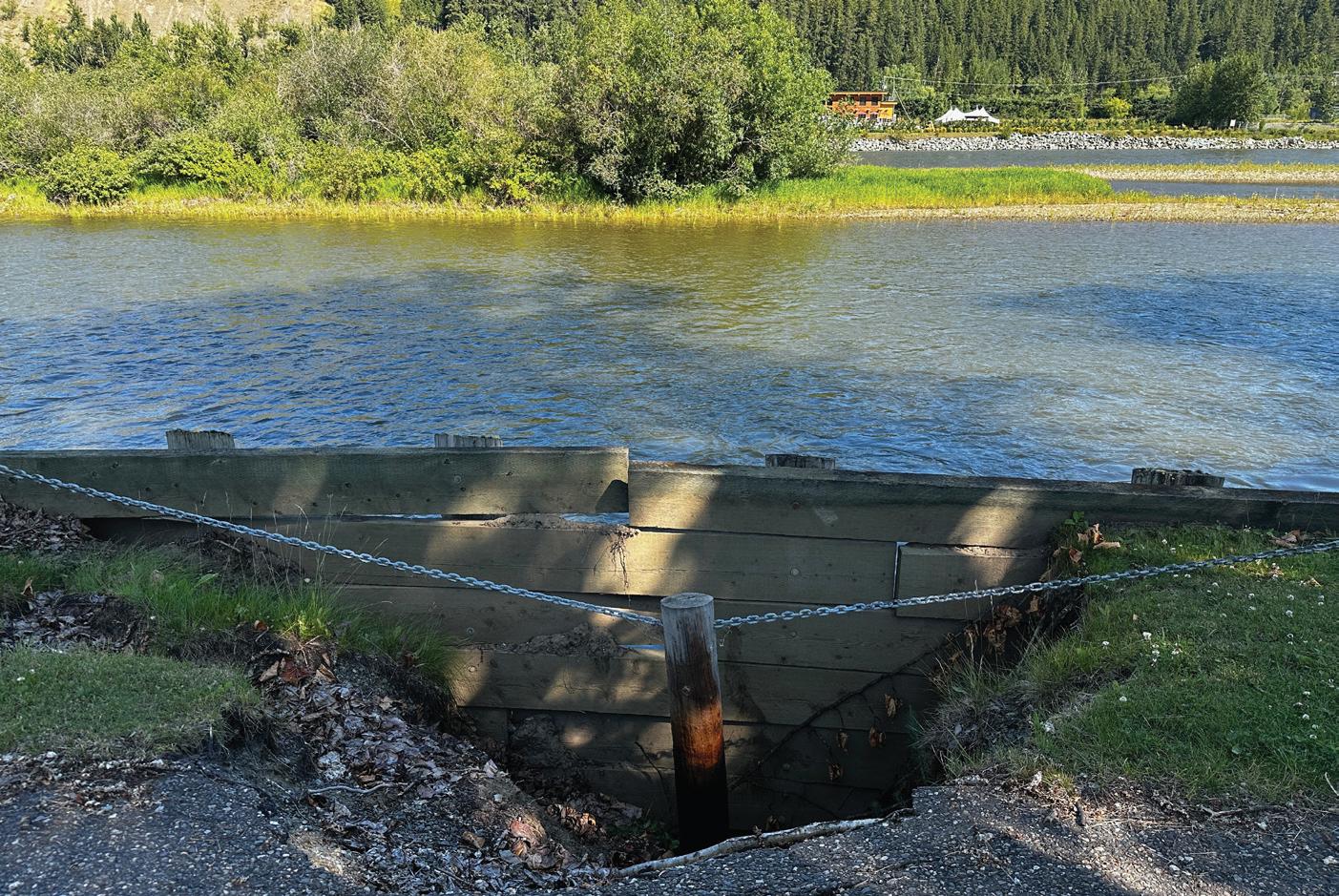
become clogged with sediment and when the high water recedes, fish are trapped in low-oxygen, disconnected pools. Since 2022, the association has been trapping fish in the channel and transporting them to safer refuges from the winter weather.
For the last four years, SCWA has been working on obtaining permission to excavate sediment from the channel and make it safe for fish once again.
Snyder said the rules aren’t as strict for the side channel as the river’s main channels, but they have had to work closely with Fisheries and Oceans Canada.
SCWA hoped to carry out the excavation this fall, but had their most recent funding request denied, leaving them to look for other sources for the remaining $60,000 to $90,000 needed for the
estimated $300,000 total bill.
Some of the funding that has been collected so far has come from mining company Rio Tinto as well as the College of New Caledonia Research Forest Society Legacy Fund.
At the same time as the excavation, Snyder said the association would contract Lheidli T’enneh First Nation to carry out slope stabilization work along about 1.5 kilometres of one of the channel’s banks.
“They’ve done a lot of research and a lot of work on the Chilako River with bank stabilization and they’ve come up with this really industrial way of planting willow trees and that sort of stuff on the sides of the bank,” Snyder said.
“What they’ll do is they go in with excavators and machines and they’ll clear off those bank and then they’ll
lay in larger logs and willow and then kind of half-bury them and put in some large stakes straight up and down to make sure that it’s actually going to hold. Once those willows start to grow, they really root in and take off and that’s what really holds the bank together.”
He said it’s a more natural solution than placing riprap on the banks, small rocks piled up as a breakwater and erosion protection measure. Riprap, he said, can cause issues with stream temperatures while willows can provide shade and habitat for bugs, which sometimes fall off the trees and into the water as food for the fish.
Unfortunately, this stabilization work might have its own nemesis — a beaver near the hatchery that has taken down several big cottonwood trees along the riverbank that they had expected to be there long-term to help secure the slope.
“That’s another issue that needs to be handled,” Snyder said.
“People aren’t always interested in getting rid of a beaver, but it’s one of those things that you have to weigh your options. Is this something we have to do or can the beaver be moved somewhere else … that’s something that I’m not 100 per cent sure what the choice would be and I’m not sure what the city’s protocol on that is either.”
Through this work, Snyder said, he hopes the relationship developed with Fisheries and Oceans Canada will eventually lead to more stabilization work along the river further west from Cottonwood Island Park.
CONTINUED ON NEXT PAGE

“I think that there’s definitely potential for it,” he said. “It depends a little bit on the space that’s available. In some of those areas, the only space you have between the water and private property is the trail. As you get up closer to Brink’s mill, I’m not 100 per cent confident that there would be enough space there to do something like that.
While Snyder said SCWA isn’t looking for volunteers for this particular project, those interested in donating funds to make it possible or volunteer for the association’s other projects can email sprucecitywildlife@gmail.com.
Robin Draper, the chair of the Cranbrook Hill Greenway Society’s board of directors, said in a Friday, Aug. 1 interview that erosion isn’t the only issue on Prince George’s trails.
Visiting The Citizen’s offices, Draper pulled out an iPad and showed photos he’d taken along the trail the day before. He pointed to areas where branches from trailside plants are encroaching on the trail, creating obstacles and reducing sightlines. While the city has no control over plant life on nearby private property, he said he thinks the brush on municipal property needs to be controlled.
Wooden bollards that looked nice when they were first installed are uprooted in several areas, still connected by metal chains or wires as they lie on the side of the path.
Near the Brink mill, chunks of wood lined up on the edge of the property have started to leave debris through gaps in the chain link fence.
Several sections of fencing separating private properties from the trail are
bent, twisted or half-collapsed. Draper said he doesn’t know whether the fences belong to the city, in which case they should be dealt with, or to the property owners, in which case the city should speak to them about cleaning them up.
He said he sees city staff looking after decorative parts of parks, like flower gardens, but doesn’t see them putting as much work into maintaining functional aspects like trails.
“We spent a couple of hundred thousand dollars on this renovation project,” Draper said of replacing the paved trails with gravel ones. “Why didn’t we clean up this stuff along there? They’ve been like that for several years now. It looks tacky.”
If there are logistical and regulatory concerns in dealing with eroded trail near the water, Draper suggested doing
what other cities do and establishing a trail further back that still has a view of the water.
With some of the vacant properties along the riverfront, he said Prince George should do what places like Vancouver do and look to acquire them for redevelopment into park space.
Asked about the active transportation strategy being updated, Draper said there have been previous, similar efforts over the years but wondered whether the findings were put into action.
“I think for some of the older people, there is a bit of frustration,” he said. “Another survey, if we do it, will (it accomplish) anything else? I’m looking at the money that was spent on trying to put a multi-use trail along Otway Road … a lot of the design was done, but then it just died, didn’t go anywhere.”
Here are some other comments on the river trails
The Citizen received after soliciting feedback in the Prince George Area Hiking Facebook group.
Amber Armstrong: “I walk the trail from Cameron St. Bridge to Fort George Park pushing a stroller the only part that bothers us is the cement blocks as you are walking towards the old Winton office. There is really no detour to get around them with a stroller so it is sketchy maneuvering.”
Tasha Dawn: “As a newcomer to (Prince George), we have walked Cottonwood many times and really don’t see the danger everyone is speaking about in these comments.”
Jada Gratton: “Personally, I like the creation of the detours — I know you’re not supposed to be walking on the eroded trails but I don’t mind, it gives the bikers the nice trail, plus gives me options to walk my reactive dog further from others when they’re passing on the main new trails.”
Ashley V. Kelly: “I walked it in June with my family. It’s getting dangerous, the detours help a bit. Honestly, I think the only option to keep it open would be looking into doing a retaining wall pretty much the entire length that is between Cameron Street and Cottonwood. There aren’t enough trees to keep the erosion from happening because the trail runs between property fences and the river in lots of places. Another option would be hiring a civil engineer.”
Erik Lang: “It’s insane that much of the damage in

Cottonwood happened during the massive ice jam in (I think) 2007. Several bridges were lost, trails along the edge started falling into the water and the City of PG did NOTHING. We eventually got the Cameron Street replacement bridge for a million dollars, which is beautiful, but I don’t understand the sense of having such a centerpiece when they do nothing about the rest of the park. No riprap along the banks to prevent further erosion, no rebuilds of the smaller bridges, no new picnic tables. We went from so many trails to just a couple of main ones. It’s embarrassing how badly this park has been treated by the city over the last 15 years.”
Kris Lee: “I’m not sure if these are needed or not along the path. Or maybe they were once buried further and due to the erosion they have become more visible? The rebar sticking out almost a foot in some spaces so close to the walkways seems extremely dangerous and I always caution my daughter to stay very far away as a wrong slip can cause you to become impaled. Seems very dangerous on a hike that is suggested to be done in this town.”
Sue Loedel: “Cottonwood Park before the ice jam damage was a true jewel in our city. I believe the Rotary clubs did or sponsored the first build of the park, there were lots of options for trail, a viewing platform overlooking the river with benches to sit and lots of smaller bridges crossing the slough. There has been no real maintenance or reconstruction of the park since the ice jam damage. The cottonwoods also need some care and a plan to preserve the wonderful carvings done by Elmer Gunderson. I don’t believe there is any information in this park about the Island Cache either. The trails do not need to be paved, that only encourages the roots to grow and buckle the surface, a good hard packed surface is better for our ice, snow and rain. It is a beautiful area in our city however like everything it is not being maintained or enhanced. Do not get me started about our boulevards, sidewalks full of weeds, etc.”
Loretta Waring: “It is getting so dangerous… this should have been addressed 10 years ago.”
COLIN SLARK Citizen Staff
The Prince George Heritage Commission is hoping that its upcoming efforts to commemorate local history will prove the value of its work after city council only approved one of several requests for more resources at recent meetings.
Back at the March 10 city council meeting, chair George Davison gave council an annual report on the commission’s activities.
During that presentation, Davison made five requests of council:
• Increase the number of annual meetings from four to seven
• Endorse reconciliation with Lheidli T’enneh First Nation through future commission projects
• Provide additional funding to update and replace heritage signs around town,
• Increase the number of members on the commission from nine to 12
• Direct staff to increase their support for the commission
In response, council referred those requests to administration for further study, also directing staff to investigate the possibility of making the commission an external entity rather than a council committee and directing the heritage sign request to a committee of the whole meeting that took place on June 25.
At the July 14 meeting, staff returned with a report on the four requests after previously addressing the signs at the June 25 committee meeting.
At that meeting, staff estimated the cost of replacing all 61 of the city’s heritage signs at a cost of around $106,000 — about $1,700 per sign. The commission had asked for $60,000 for the project.
Ultimately, the committee moved for the heritage sign project to be included for consideration with the city’s 2026 budget.
Regarding an increase in meetings, administration said it would provide

commission members more opportunities to meet, but it would increase the workload for staff tasked with assisting it.
“Under the current quarterly meeting schedule, the number of agenda items remains limited, and few tangible deliverables are reported,” the report said, recommending no change to the number of meetings.
“Staff are able to support the commission at this frequency, as the associated responsibilities with the commission are managed in addition to their primary duties.”
On reconciliation, staff recommended that efforts continue to be pursued through the memorandum of understanding on communications and co-operation between the city and Lheidli T’enneh but said they could engage the First Nation should a heritage project come up that would benefit from its input.
To increase the size of the commission, staff said, they would need direction from council to prepare a bylaw amendment.
The section on increasing staff support received the most attention in the report. It said that under the bylaw establishing the Heritage Commission, the city manager appoints two members of city staff to assist its work: a staff liaison and a committee clerk.
“The staff liaison role is currently assigned to a land use planner within the development services division,” the report said.
“This responsibility is in addition to the planner’s core duties and day-to-day workload. Expanding the staff liaison role to provide additional support to the commission would significantly impact
the planner’s capacity to manage existing workload, potentially resulting in delays and increased processing times within the division.”
On top of that, the report said that enhancing the staff liaison role is not currently contained within the planner’s job description and would need approval through the Canadian Union of Public Employees (CUPE).
Because of that, staff recommend that the city instead add a heritage planner if they wanted to pursue the action.
“At this time, administration is unable
to determine whether the creation of a new position is warranted, as the commission’s current level of activity and number of deliverables remain limited,” the report said.
“A clearer understanding of the commission’s future scope and workload would be necessary to justify and define the need for additional staffing resources.”
The final section of the report addresses potentially spinning off the commission into an outside entity, which is allowed under BC’s Local Government Act.
It argued that such a move would allow the commission to address a wider ranger of funding opportunities, have greater autonomy, be more flexible and “establish a governance structure tailored to its mission, potentially enhancing its credibility and visibility within the community.”
CONTINUED ON NEXT PAGE

Coun. Trudy Klassen moved a motion calling for extra commission meetings, saying the city needs to enable its committees to have success and that it’s no wonder they aren’t getting much done with only four meetings a year.
Manager of legislative services Ethan Anderson said that after the Standing Committee on Public Safety was created by Mayor Simon Yu last year as well as the creation of a committee reviewing council remuneration at the same meeting, his staff are stretched thin already.
He requested that council consider holding off on the idea until 2027, after his department is finished organizing next year’s municipal election.
The motion was defeated.
Coun. Garth Frizzell moved for staff to work on bylaw amendments to increase the number of committee members. It passed.
Klassen then moved the item regarding engaging with Lheidli T’enneh on future projects. She said she thought it was important to honour the commission’s request.
City manager Walter Babicz brought up the existing memorandum of understanding, saying it is administration’s preference that liaising between the commission and the First Nations be handled by either the city’s intergovernmental department or itself.
Coun. Cori Ramsay said she thought Lheidli T’enneh should be part of the discussion and wondered whether it would be worth having city staff discuss the matter with the First Nation’s staff, especially since the heritage sign project will be discussed during the next budget cycle.
Ultimately, council voted to direct staff to engage the First Nation on the matter.
On the final item, Klassen moved for an investigation into providing the commission with additional staff resources. It carried.
At the Monday, July 28 council meeting, councillors approved the first three readings of a bylaw amendment that would increase membership from the
current maximum of nine to 12.
Included in those three new positions are dedicated seats for representatives from the Prince George Public Library, The Exploration Place and one additional member of the general public.
Speaking to The Citizen after a special meeting of the commission on Tuesday, July 29, Davison said when he first joined five years ago, he had the goal of recognizing two notable people from Prince George’s past: Charles Sager, a black barber who called out racism in the city in the 1920s and Steve Berlinic, a victim of work camps near the city during the great depression.
However, he came to realize that there was more work to deal with existing efforts like heritage signs dedicated to buildings that no longer exist than new projects.
While representatives from the library and museum were welcomed to the commission’s meetings, they weren’t members and couldn’t often speak.
“Adding designated seats for those two entities makes a lot of sense because they are partners in heritage in Prince George,” Davison said. “That was the only one of our recommendations that really got through.”
Even before the membership expansion, the commission had already been searching for someone to volunteer for a vacancy.
One area where Davison said the commission and the city have compromised is on meetings. He said they had recently received their schedule for the next year and a half and it includes the addition of special meetings between some of the four regular meetings.
Davison said that there was a challenge for the commission in having its last meeting of a calendar year in December and having to wait until March to present their final report for the previous year.
Included in the schedule is a special meeting in January to help fill in that gap.
Speaking about the request for extra staff support, Davison said the commission has been tied to the city’s planning department for years because of the

requirements associated with adding buildings to the heritage register.
However, he noted that there haven’t been any new additions to the register since 2018 and the commission’s work noticeably slowed down since the onset of the COVID-19 pandemic.
As one example, Knox United Church in downtown Prince George, was on track to be added to the register but the process was never completed. The commission is now working with the church to get that process going again and hopefully add the church to the register later this year after being submitted to council for approval.
At this point, Davison said, just about every heritage building that could be added to the register has been nominated.
Vice-chair Ayesha Rogers — an adjunct professor of anthropology at the University of Northern BC — has pointed out that heritage is more than just buildings. It’s also sight lines, neighbourhoods, industrial history, educational history and people.
There are also a lot of buildings that no longer exist — like the Shasta Café or Columbus Hotel — or no longer match their original use — like the Northern Hardware building. Though they may be altered or gone, they can still be acknowledged.
“The plan is to broaden the definition of heritage, invite and engage the public in what heritage is in Prince George and
then have some recognition either on the register or beyond the register,” Davison said.
The early stages of recognizing these other heritage elements is starting this summer, with commission members due to set up shop in the old South Fort George School House near the Exploration Place on days when the Little Prince miniature train is running.
There’s no set process for how those other elements will be recognized and Davison said that’s something they’d like to have city staff help with.
While administration had criticism over a lack of results from the commission, Davison said it’s a catch-22. They’re not recommended to receive more resources because of a lack of results and they have a lack of results due to a lack of resources.
Going forward, the commission wants to make a splash and show the importance and desire of commemorating local history.
“We’re hoping that this is going to maybe break that cycle,” Rogers said. As for the suggestion that the commission becomes a separate non-profit, Davison is against the idea.
“The city has a responsibility to maintain and celebrate its heritage,” Davison said. “It’s not something that a non-profit society can do effectively. A non-profit can’t do the register because that’s a formal registry that’s under provincial legislation, not just a city bylaw.”
Rogers pointed out that under the city’s Official Community Plan, the city “states clearly and repeatedly how important heritage is to Prince George, the role that it plays in terms of identity and sense of place.”
“It also states repeatedly that the responsibility of the city is to support and to help and to manage the heritage in Prince George, so it (the city) can’t turn around and say ‘but it’s too much trouble dealing with the body we created to do that, so why don’t they become a little club?’” she said.
The Heritage Commission’s next regular meeting is scheduled for Thursday, Sept. 11 at 11 a.m. in the second-floor boardroom at Prince George City Hall.
Two longtime Prince George residents are being recognized with one of British Columbia’s highest civilian honours for their extraordinary efforts to turn theatre into a force for good.
Ted Price and Anne Laughlin have been named recipients of the 2025 Medal of Good Citizenship, celebrating their dedication to founding and volunteering with Miracle Theatre, a local company that channels its entire proceeds toward local charities.
Price and Laughlin are among 18 British Columbians being honoured this year as the province marks the 10th anniversary of the Medal of Good Citizenship, established in 2015 to recognize selfless acts that benefit communities without expectation of reward.
Through Miracle Theatre, Price and Laughlin have used the performing arts not just to entertain, but to raise more than $1 million for causes such as
youth programs, hospice care and food security, including $209,433.40 this year to establish a Prince George Seniors Emergency Fund.
“They’ve transformed theatre into a lifeline for charities,” said the Honourable Anne Kang, Minister of Tourism, Arts, Culture and Sport, and chair of the selection committee, in a statement. “Their work exemplifies the very best of what it means to be a British Columbian.”
Premier David Eby echoed that sentiment, saying this year’s recipients, including Price and Laughlin, “exemplify what it means to be a good citizen by selflessly stepping up to help their fellow British Columbians with kindness, compassion and commitment.”
The 2025 recipients join a distinguished group of honourees recognized since the program’s inception. To date, 196 Medals of Good Citizenship have been awarded across the province. Presentation ceremonies are scheduled for the fall.
COLIN SLARK Citizen Staff
Class will be in session starting Thursday, July 31 at the South Fort George School House near the Exploration Place thanks to the Prince George Heritage Commission.
At a special meeting of the commission held at city hall on Tuesday, July 29, members heard that they had been invited by The Exploration Place to host information sessions at the school house on days when the Little Prince train is operating through the rest of the current season.
The building was the first school in South Fort George, originally built in 1910 at the corner of Thapage Lane and Queensway before it was donated to the museum in 1976 and later moved.
In its current location, the school is situated right next to the historic train station where visitors line up to ride the miniature train. Currently, the Little

Prince runs on Thursdays from 3 p.m. to 7 p.m. and Saturdays from noon to 4 p.m.
The commission’s members unanimously approved running the information sessions as well as applying for a booth at the British Columbia Northern Exhibition being held from Aug. 14 to 17.
Speaking to The Citizen after the meeting, chair George Davison and vice-chair Ayesha Rogers said they think a lot of locals don’t know about the commission and their work and they want to use this opportunity to educate them.
“We hope to introduce the idea of what the job of the commission is and what they do,” Rogers said.
“And also to get people involved, actually talking about what they feel is the heritage or the things about Prince George that, for them, really give it meaning.”
Davison said the sessions will be a dry run for what the commission hopes will be a larger, more serious project creating an inventory of heritage elements in the city.
On Sunday, August 10, crews will be performing maintenance tasks on the high voltage transmission lines serving the Bulkley Valley which will require the power to be turned off to the communities of Telkwa, Smithers, New Hazelton, Hazelton and as far west as the junction of Hwy 16 & Hwy 37 at Kitwanga. This outage will run from 8am to approximately 4pm.
All impacted customers will be notified before the event via telephone auto-dialer, email, or postcards.
Travelers passing through the outage zone need to be aware services such as fuel, charging and food will not be available during the power outage.
We apologize for the inconvenience this outage may cause. However, we need to ensure the safety of the public and the crews involved as we conduct this necessary maintenance work.
Thank you for your patience and understanding.
For more information, email us at projects@bchydro.com or call BC Hydro at 1 800 BCHYDRO (1 800 224 9376).
KENNEDY GORDON Citizen Managing Editor
At first glance, it’s easy to assume the city has forgotten about the Heritage River Trail. The route through some of Prince George’s most scenic riverfront — particularly from the Cameron Street Bridge to Cottonwood Island Park — now has detours and barricades, with some sections reduced to treacherous slivers of asphalt clinging to crumbling banks.
Locals are right to be frustrated. What was once a crown jewel of outdoor recreation is now littered with debris, eroded shoulders and the unsettling sight of concrete barriers where families used to ride, walk and explore freely. But despite the visible neglect, the truth is more complicated — and more important — than it first appears.
The damage, for starters, isn’t manmade. It’s the result of intense natural forces: spring runoff, shifting sediment and an ice jam that caused a lot of destruction a few years ago.
And while it may seem like the city has dragged its feet in repairing what’s been lost, the delay stems not from apathy but from a complex web of environmental regulations and logistic constraints.
Cottonwood Island Park and the Nechako River are designated critical habitat for the endangered white sturgeon. That means any erosion mitigation or trail repair within this zone must be approved by Fisheries and Oceans

meant to hold the bank in place. Add in denied grant applications and multiagency coordination, and it is clear that repairing the trail isn’t as easy as just laying down fresh gravel.
While endangered species protections may limit what can be done at the river’s edge, that doesn’t mean the city is powerless.
We acknowledge the fnancial support of the government of Canada.
Nous reconnaissons l’appui fnancier du gouvernement du Canada.


Canada, with strict conditions and costly offsetting measures attached.
On the opposite side of the river, Northern Lights Winery, the Fresh Water Fisheries’ Prince George Trout Facility, and a private residence — at their cost — with permitting assistance from the City of Prince George had riprap installed in 2016 to prevent the erosion of their banks. The project has proven quite successful.
While the city worked to protect the north shore, it missed the opportunity in 2015 and 2016 to protect the south shore, and our riverfront trail network. Whether that decision was due to a lack of vision or an unwillingness to allocate funding, the result is the rapid deterioration of a beloved walking path.
In 2019, a change to the federal Fisheries Act made the environmental regulation requirements even more rigorous. Routine repairs or installing new sections of riprap are now far more expensive and take even longer to carry out.

Stolz Owner / Publisher

Terresa Randall-Stolz Owner
This doesn’t mean the city has done nothing. In fact, trail renewal continues every year, with 2.1 kilometres of gravel resurfacing completed in 2024. Bridges have been rebuilt. Park amenities upgraded.
Meanwhile, groups like the Spruce City Wildlife Association (SCWA) are working on complementary habitat restoration projects, such as clearing sediment from a clogged side channel and stabilizing banks using eco-friendly techniques involving willows and root structures.
Of course, these explanations don’t erase the very real concerns raised by residents — especially those dealing with dangerous rebar, broken fences, or overgrown trails.
But this work takes both time and money while navigating a frustrating amount of red tape.
As SCWA president Dustin Snyder pointed out, even something as simple as slope stabilization can be delayed by a single beaver felling the very trees

Kennedy Gordon Managing Editor
As Robin Draper of the Cranbrook Hill Greenway Society rightly suggested, new trail alignments set farther from the water could be explored, especially along sections where erosion has left little room to manoeuvre.
Public frustration is valid, so is public expectation, however, it is important to recognize that some problems are not simply the result of neglect — they’re the byproduct of trying to navigate federal red tape.
We are situated on two major rivers, with all the environmental responsibilities that come with that geography. Choosing to protect our fish, our ecosystems, and our shoreline doesn’t mean we abandon public infrastructure. It means we find smarter, more sustainable ways to rebuild it.
In the meantime, we should remember that things aren’t always as simple as they appear.
Sometimes the path forward involves taking a detour. Let’s ensure the Heritage River Trail becomes one we can be proud of, and one that future generations can enjoy.
Share your opinion on this with a letter to the editor: editor@pgcitizen.ca.
OFFICE (8:30a - 4:30p)
505 Fourth Avenue
Prince George, B.C. V2L 3H2
FRONT DESK AND CLASSIFIED frontdesk@pgcitzen.ca 250-562-2441
NEWS AND SPORTS news@pgcitzen.ca
LETTERS TO THE EDITOR editor@pgcitzen.ca
OWNER / PUBLISHER owner@pgcitzen.ca
Letters to the editor are welcome. The maximum length is 300 words. Letters may be subject to editing for length, clarity, grammar, spelling and legalities prior to publication. Please include your daytime contact information.
Editorial: Prince George’s motel housing strategy failing as we pay the price
Why would the city pay more than assessed value? And why pay thousands more for a third-party appraisal when the assessed value has already been set by an accredited commercial appraiser at BCA and if incorrect has been appealed to the Assessment Appeal Board.
I guarantee the owner would have appealed if the assessed value in the year of sale was $4 M.
BECAUSE IT’S NOT WORTH THAT MUCH!
F. Berry
Prince George council gets rst look at results of yearlong parking study
I don’t know who was counting but off-street parking at the hospital is all but impossible to find during the peak hours.
’ve missed, been late or just plain cancelled appointments because there is no parking whatsoever.
As a senior it’s difficult to walk two block or more, especially in the winter.
With the hospital being as busy as it is, appointments and procedures are often late in starting so late in finishing so the cost either goes up through no fault of users or we are given an exorbitant fine.
Where’s the concern for the patients in this?
Terri Turcotte
Prince George council gives green light to retail crime forum
Really another forum to discuss a problem that is already well known and documented? How about concrete action instead of holding another wasteful meeting to discuss something that apparently city council is completely in the dark about. How about getting some courage and actually deal with the cause which is the homeless, the addicts and the street walkers. They are responsible for a good portion of crimes committed and the reason why people are scared to be in the bowl at night. Better yet strike up another committee, forum or public town hall to discuss what I just posted to see if it’s real or not.
So far the city has a poor track record in this going back 15 plus years and still haven’t done much except nod your heads and say let’s have another forum/meeting.
Dearth
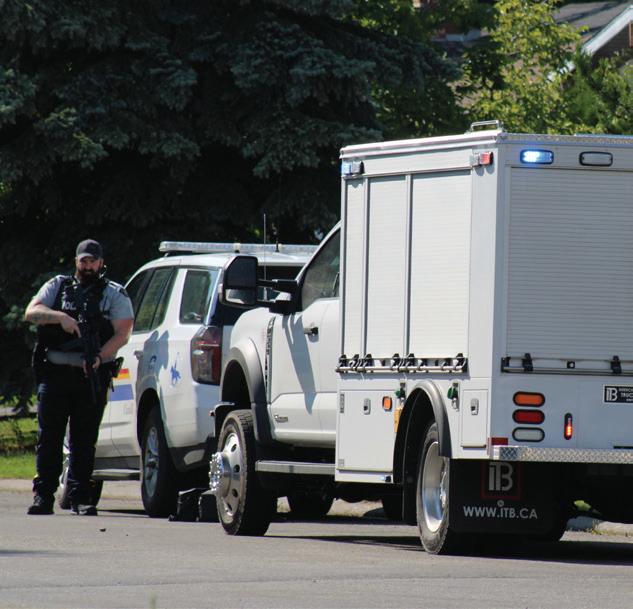

Snow control pilot project gets the go-ahead from Prince George councillors

Simply cutting snow clearing to save money is the lazy man’s approach. The snow will still be there after the stat but much harder to clear.
A better way is eliminate waste in the $10 million budget.
Some suggestions:
During shoulder seasons & stretches with no snow, city plow equipment can be seen driving around town with blade high in the air because it hadn’t snowed in weeks and every corner already sanded. Each one burning $100 or more of fuel per shift and a couple of hundred in wages wasted.
Work with the union to find other jobs that need doing that equipment operators could complete during slow times. Wages could be removed from snow budget and charged to another department.
Stop the idiotic practice of stopping residential clearing and returning all equipment to the CBD because another 23 flakes fell on the downtown core since the last time it was cleaned.
Bobs your uncle
Final rezoning granted to former Millennium Park property
I don’t know that this was ever really a great site for a park, but I expect that nearby office workers would have used it at break times.
Unfortunately in was absolutely devoured by street people. Nearby businesses like the gas station across the street suffered as well.
Basically, we can’t have parks or anything else for the enjoyment of the general public in our downtown because street people have moved in uncontested.
Look at the WDIC park on 5th Avenue. How much has the city recently spent on it’s construction and is currently spending on it’s maintenance?
Walk by it on a sunny afternoon and music is blaring, drugs are openly used, and tax payers quicken their pace to avoid it.
PGLocal

Final rezoning granted to former Millennium Park property
Its too funny...you, me and most everyone else see and realize this.
But the small bunch that are paid , elected to see and fix these sort of thing just seem to think meetings after meetings will eventually magically fix it.
L Larue
A ag was raised last week to draw attention to the crisis
MATTHEW HILLIER Citizen Staff
A new flag now hangs above City Hall — one that reminds residents about the impacts of the ongoing toxic drug crisis in our communities.
Positive Living North, Broken Hearts of Fentanyl and Moms Stop the Harm, alongside community partners, local MLAs and members of mayor and council, gathered outside City Hall to raise a purple flag in memory of the lives lost to this crisis and to show empathy for those currently suffering with substance use challenges.
Mayor Yu, before raising the flag, proclaimed that August will now be International Overdose/Poisoning Awareness Month.
Moms Stop the Harm and Broken Hearts of Fentanyl stated that August will be a month to educate, stop stigma and raise awareness about the toxic drug crisis both in BC and Canada as a whole.
Mary McDonald, who lost a son to this crisis, shared her story with The Citizen and explained why this movement means so much to her.
“My son, his name was Luke Landry,” said McDonald. “He was 35 years old. He died in Moncton, New Brunswick. His death was very publicized because I was very upset about what took place. He had gotten out of jail that morning — just on a misdemeanor — and he hadn’t had any drug use for over eight months. Somebody gave him a drug. What he was given was three times stronger than any fentanyl. I was told by the coroner that there was no medical purpose for this drug. This drug was used to kill people. He died on the streets of Moncton.
“He went and asked for help. He was at a Connection, where they could take drugs safely. This drug he took from somebody else, and they kept him there until seven o’clock that evening after giving him two treatments of naloxone.
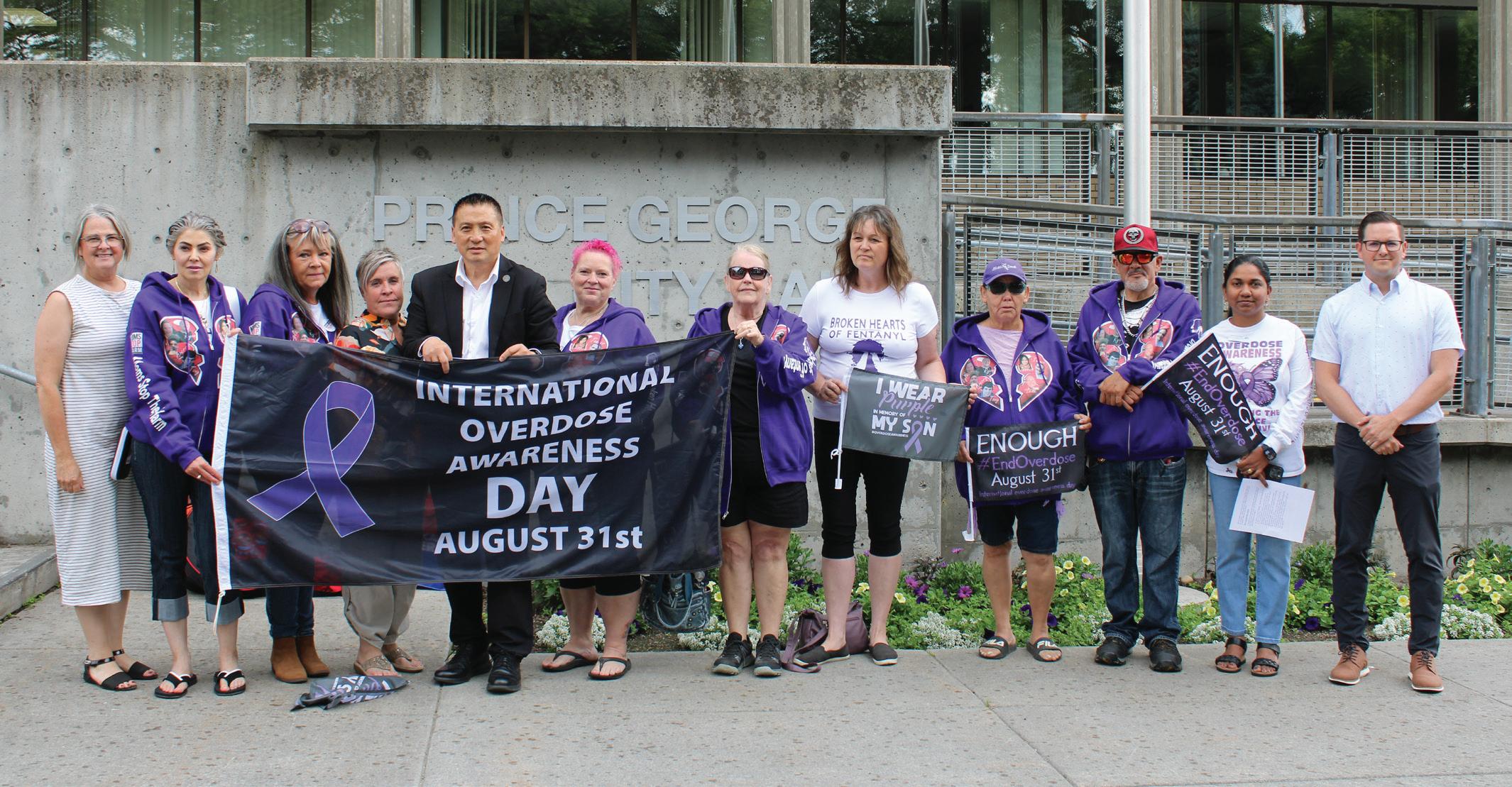
They didn’t have a place to put him … They put him on the street when he couldn’t walk or talk right, and he walked all around Moncton trying to get some help and ended up dying in a public washroom in front of the city hall.”
McDonald has been a strong advocate since that day and has found community in Broken Hearts of Fentanyl and Moms Stop the Harm.
“It’s my safe place,” said McDonald. “We are so criticized in public. Everybody blames everybody for these crises. They blame everybody — that if you were a better mother, if you had done any of these things … You can’t talk to everybody about this. You can’t even talk necessarily to your own family about how you feel, because they don’t understand. And you can’t understand unless you’ve heard of it. And these wonderful people that I joined — we love one another, and we try to hold one another up. That’s why this group is very important to me.”
Michelle Miller, a member of Moms Stop the Harm and Broken Hearts of Fentanyl, who lost her son Tanner to the toxic drug crisis, spoke to the media
following the flag raising and raised concerns about the rise in stigma against those with substance use challenges.
“I think language matters, and we’ve worked really hard on that. It’s really important that we don’t label people by calling them addicts. That’s old language,” said Miller. “We don’t label and demean people. It’s people with substance challenges, mental health challenges. They’re all individual people, and the 12-step programs — they tend to label still with their old language.
“It’s really hard on somebody. They’re already down and out, and the families are trying really hard to work with their kids. I’ve been through that journey with my son, and I made mistakes as a mom. But I have learned over the years that you don’t let go of your kids. You stick it out with them, and hopefully one day, there might be a treatment centre here that will be able to help people.”
With recent stats released from the BC Coroners Service showing that 23 people have died in Prince George this year from the toxic drug supply, Miller said that although the numbers are down from last year, this crisis is still far
from over.
“Unfortunately, we still don’t have the support for treatments for people who are in full addiction,” said Miller. “That’s one piece of the puzzle that needs to be fixed. The numbers — they’re 23 — you know, those numbers aren’t accurate because there are a number of people who have passed away. I know of three in the past month, and it’s just because we’re out there every day trying our hardest to make people aware. People at home need to be aware too — like, their kids are at risk. Their young teenage kids in high school, even elementary school, are at risk of overdose and poisoning. You know, there’s fake Molly out there, there’s fake Xanax bars out there.”
Local MLA Kiel Giddens joined those in attendance at the flag raising. Giddens expressed concern about the over-representation of drug deaths in the trades, transport and heavy machinery sectors — an issue also highlighted in the recent data from the BC Coroners Service.
CONTINUED FROM PREVIOUS PAGE
“For the first time ever, the coroner has actually included the occupations of those who have lost their lives,” said Giddens. “Twenty-two per cent over the last two months have been workers in trades, in transport, and in heavy equipment operation. This is something that we’ve known for quite some time, but now we’re seeing real evidence from the coroner. We need to support all families — including working people — to make sure that they’re not falling victim to this toxic crisis. So supporting those in the trades and our working people in this province is something that we’re calling out — to make sure that we’re doing everything we can to make sure working people are safe, that they’re working safely, that they’re being safe, and that they know that there’s help when they need it.”
He also stated that more effective and targeted treatment programs and
outreach are needed to ensure workers receive the critical support they require.
“I worked in industry before being elected,” said Giddens. “We worked very hard to make sure that there was access to help, support. Not all trades and technology and transport companies have that capacity. We need to make sure that we have things in place — that they can access that help when they need it.”
Giddens told The Citizen that he has seen this issue hit the trades industry in Prince George directly, and that he wants to ensure workers receive the protections they need.
“Prince George is an industry town,” said Giddens. “We have people who power our mills. We have people who are delivering logs to our sawmills. We have construction workers working across the region. Absolutely, this is a huge issue for Prince George, and that’s why we want to make sure workers are
CITIZEN STAFF
After months of uncertainty, Northern Health has confirmed that maternity care for high-risk pregnancies at the University Hospital of Northern BC (UHNBC) will continue uninterrupted through August and September, following a successful push to fill critical staffing gaps.
The update comes as a relief to residents across Northern BC where UHNBC serves as the region’s only tertiary obstetrics care centre. Earlier warnings had indicated that due to a shortage of Royal College-certified obstetricians and gynecologists, patients with complex pregnancies might need to be transferred to hospitals in Kamloops, Kelowna or Vancouver to deliver safely.
Now, through the concerted efforts of UHNBC’s obstetrics and gynecology
safe, protected, and that they have the help they need here in Prince George — let alone the rest of the province.”
Prince George MLA Rosalyn Bird also joined attendees and passionately spoke about an upcoming first-of-itskind event that she hopes will help slow the drug crisis in the city.
“Prince George is going to be the first city in BC — possibly Canada — to have a prescription drug take-back day,” said Bird. “That is going to be recognized along with International Overdose Awareness Day. The event is intended to help people understand that although there may be drugs available on the street — that’s criminal diversion — there’s also something that I call soft diversion, where people are using unused medications or extra medications. They’re removing them from medicine cabinets — whether it is seniors filling prescriptions through pharmacare and selling them to buy groceries, or adults using
parents’ medications to self-medicate and possibly self-harm through suicide. Those drugs need to come out of our medicine cabinets every year.”
This event will take place on Aug. 28 on-site at City Hall to collect prescription medications, vaping devices (with batteries removed) and other drug-related supplies — anonymously and without judgment.
Bird told the media there are other ways people can help manage the toxic drug crisis in Prince George.
“They should talk about it,” said Bird. “If they have somebody who is engaged in addiction challenges, or they have mental health challenges, or they are not residing in a home and they need help — they need to be talking about that. They need to talk to council, they need to talk to their MLAs, they need to reach out to resources in town, so that we can all work together as a community to try and help these individuals.”

team, support from locum specialists and ongoing recruitment efforts, all on-call positions for the next two months have been secured, Northern Health has announced.
The original announcement in late July drew harsh criticism from local MLAs and opposition parties. Prince George-Mackenzie MLA Kiel Giddens and Prince George-Valemount MLA Rosalyn Bird accused the province of treating rural residents as “second-class citizens” and failing to act despite knowing about the staffing crisis since January.
Doctors of BC and Northern Health officials acknowledged that UHNBC currently operates with only three obstetricians in a unit built for eight. Recruitment from across Canada and internationally remains ongoing, though credentialing for foreign-trained doctors takes time.
It’s never too early to get ready for back to school with Ave Maria Specialties. We have everything you need from Children’s multi vitamins and supplements to school supplies and everything in between we’ve got you covered. We even have lunchboxes and books to help get your kids excited to go back to their day to day learning.
Come in
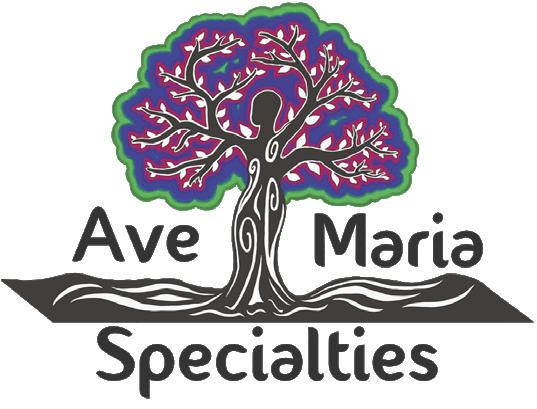

Cree Parenteau was one of the two people who died in the blaze on July 25
MATTHEW HILLIER Citizen Staff
A recent structure fire at a Strathcona Avenue residence has left two people dead and a local family homeless.
Veronica Bock, a harm reduction worker at The Fire Pit in Prince George, lost her daughter, Cree Parenteau, in the July 25 blaze. She has launched a GoFundMe to support her family during the tragedy.
She spoke to The Citizen about why she started the fundraiser.
“We had a house fire and everything was lost,” said Bock. “Even my daughter died in this house fire. I started it to get help so that we could get a new house and all the furniture, all the clothes — we lost everything. Everything’s gone. So I’m just hoping to be able to get help with this.”
Bock was not at home at the time of the fire and explained what happened when she found out.
“I was here at work at The Fire Pit and my landlord phoned me and I heard my house was on fire,” she said. “I’m like, ‘oh, I’m at work. I don’t know anything about it.’ I phoned down to my house and it went automatically to voicemail. I was a bit worried about it … I went down and the house — there were fire trucks, ambulance, everything all over. It was on fire and they were taking people away. Then they said there were a couple of people still in the house.
“By the time I got there, they had already put the fire out. They said there were still a couple of people in there, and my daughter was unaccounted for, and then another person was unaccounted for … We don’t know how it started. They’re doing an investigation right now. We have no idea what’s going on yet.”
She added that RCMP told her she will not be able to take possession of her

daughter’s body until the investigation is complete, which may take up to a month.
Members of Bock’s family are currently staying in hotels in the city with assistance from the Red Cross. They are
asking members of the community to reach out if they know of, or are willing to rent, a space that could accommodate the family.
“I’m asking for help to just get back to normal,” said Bock. “I just want to get
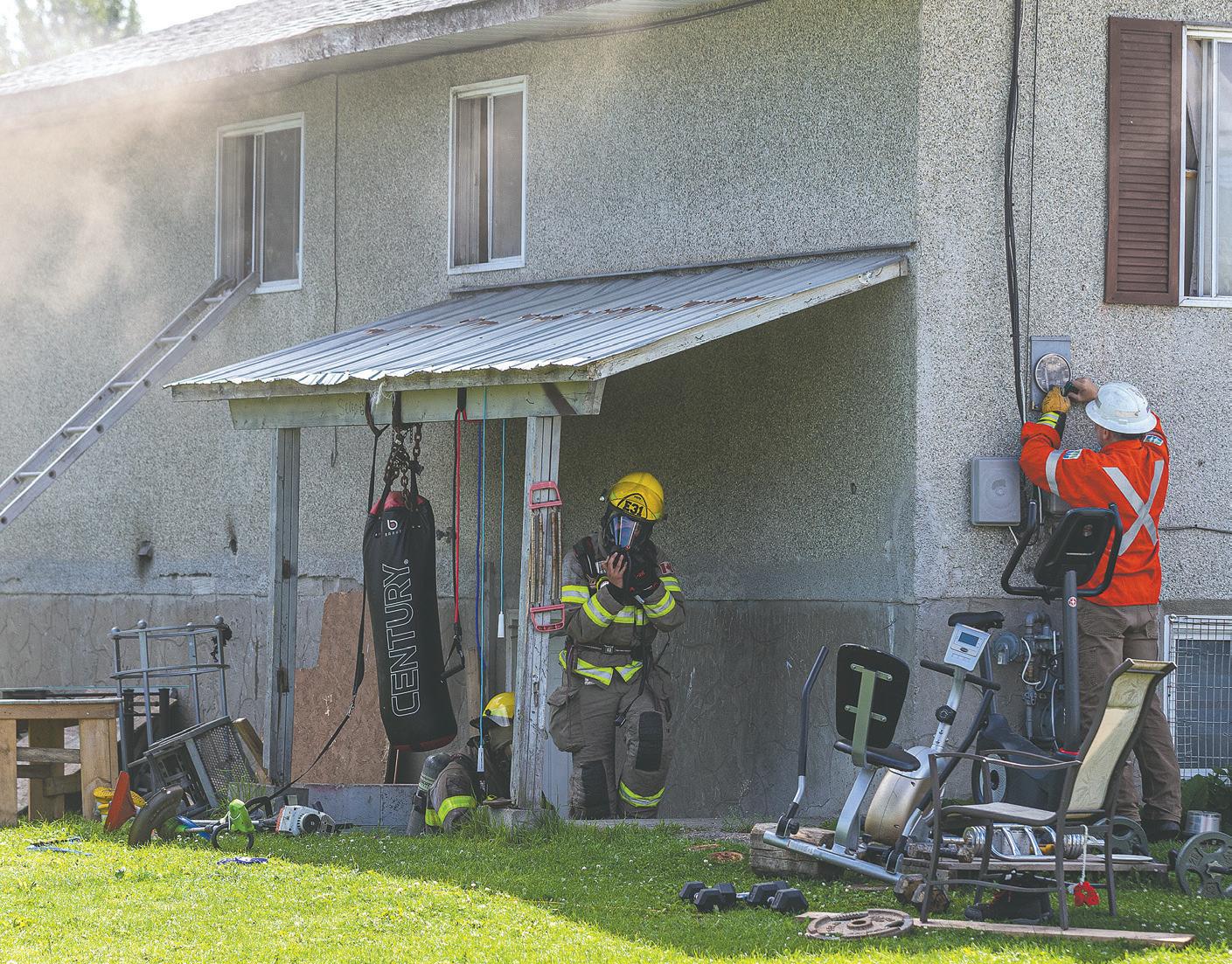
back to normal as quickly as I can and I’m hoping that somebody will have a house that we can rent. That’s the main thing we need. We need a house that we can rent. It’s just so hard to find a place right now. We can afford up to $2,500 a month when everybody puts our money together. I’m just hoping somebody will have a place.”
She said the GoFundMe campaign will help with clothing, furniture and other essentials for everyone displaced in the fire.
“There were five adults, two dogs — and my dog even got stuck under the bed,” she said. “He was in there for 20 minutes in the fire. I think he’s got post-traumatic stress disorder because now he won’t eat. He’s so lost, my little dog.”
Bock also shared one of her most treasured memories of her daughter.
“I was an addict for 20 years,” she said. “I spent all their childhood as an addict. They lived with their grandma, but Cree gave me a big hug one time after I sobered up, and I’ve been clean for over 10 years. She gave me a big hug and said, ‘I forgive you, Mom.’
“That is the one day I remember the most, and that just hit my heart, because I love her so much. She’s my baby, and now she’s gone.”
She added a few words to the Prince George community about the loss of her daughter and her family’s displacement.
“I just want people to know that Cree Parenteau is loved and she’s gonna be missed. And the other victim was a good kid, and they’re gonna be missed. I just want them to know that.
“As soon as I have information about when her funeral will happen, I’ll have it out there for people to know. I just want people to help me as much as they can. If they don’t mind, I just need to replace everything that’s lost. And I wish we knew what started the fire, so I can explain to people what’s going on.”
To support Bock and her family, donations can be made at: gofundme.com/f/ home-and-all-contents-lost-in-a-housefire-please-help
RCMP say the fire is not considered suspicious.
A worker was injured by a thrown rock as the thieves ed
MATTHEW HILLIER Citizen Staff
Prince George RCMP are investigating an early-morning robbery at the Canco Gas + One Stop Convenience Store.
The suspects entered the gas station at approximately 4 a.m. on July 30 by breaking a front-facing window using a brick and climbing through the broken glass.
A worker was inside at the time.
Staff said the suspects stole approximately $400 in cash and $200 worth of cigarettes and lottery tickets.
“Police officers flooded the area and quickly located and arrested two suspects,” stated Corporal Jennifer Cooper, media relations officer for the Prince George RCMP.
The North District Emergency Response Team, Prince George RCMP and the Problem-Oriented Policing Team executed a search warrant on Redwood Street on Tuesday, July 30.
Citizen staff reported seeing RCMP vehicles arrive at the scene around 11:30 a.m., after which officers blocked off the street.
Several loud bangs were heard during the incident. RCMP later confirmed they were flashbangs and smoke bombs, not gunshots.
An armoured vehicle was also brought in.
RCMP told The Citizen the warrant was executed under the Controlled Drugs and Substances Act. At least two individuals are believed to have been arrested at the scene.
Police have not released details about any arrests or whether illicit substances were seized at the time of writing.
“One suspect has since been released, while the other will remain in custody awaiting a bail hearing. Currently, there are still three suspects police are working to identify.”
In security footage shown to The Citizen, a worker can be seen receiving minor injuries to his legs after the suspects threw a stone at him while fleeing.
As well, a manager at the location noted that two of the suspects were known to them as they had visited the store prior to the robbery.
RCMP say this investigation is still in the early stages and investigators would like to speak with anyone who may have witnessed or who may have cell phone or dash camera footage of the robbery, or who has video surveillance from the area before or following the robbery.
Contact the Prince George RCMP at 250-561-3300 or anonymously contact Crime Stoppers at 1-800-222-8477 or online at www.northernbccrimestoppers.ca.
Prince George RCMP are looking for a man wanted on two charges relating to violating court orders.

Braun
Police say 52-year-old Kenny Joe Braun is wanted on an endorsed warrant for charges of driving while disqualified and breach of an undertaking. Under the Criminal Code of Canada, a person found guilty of driving while disqualified can be sentenced up to five years in prison.
Braun is a Caucasian man who stands five-foot-nine inches tall (175 centimetres), weighing 230 pounds (104 kilograms) and has brown hair.
Anyone with information about Braun is asked to call Prince George RCMP at 250-561-3300 or report anonymously to Crime Stoppers by calling 1-800-222-8477.


The IIO says charges are warranted after a person was shot during a traf c stop
The president of the National Police Federation is criticizing what he calls “unacceptable” delays in police oversight investigations, following a recent referral by BC’s Independent Investigations Office in a 2021 Prince George police shooting.
“Once again, a case under investigation by the Independent Investigations Office (IIO) of B.C. has stretched over four years – a length of time that is simply unacceptable to our Members and
to all British Columbians,” Brian Sauvé, president and CEO of the NPF, said in a statement Friday, Aug. 1.
The case stems from a May 31, 2021 incident in Prince George where an RCMP traffic stop near the North Star Inn at Victoria Street and 15th Avenue in Prince George.
An interaction followed, during which officers discharged their firearms, and a man sustained a serious gunshot wound.
Police reportedly provided first aid at the scene until Emergency Health Services arrived and transported the male driver to hospital with what was described as a serious, life-threatening injury.
The IIO said this week it has concluded its investigation and found reasonable grounds to believe a Mountie
may have committed an offence in connection with the use of a firearm. The matter has now been referred to the BC Prosecution Service, which will decide whether charges are warranted.
But Sauvé says the years-long delay has unfairly harmed the officer involved and eroded public trust.
“Despite announcing their decision to refer this case to Crown Counsel, the IIO has also refused to release any meaningful details to the public,” Sauvé said. “This vilifies our member who risks being presumed guilty in the court of public opinion long before any charge approval decision is made.”
The IIO said further details are being withheld to avoid prejudicing any future prosecution.
Sauvé is calling on the province to
address what he describes as “systemic failures” in oversight investigations, including delays, lack of transparency, and insufficient resources.
“Our members deserve better. The public deserves better,” he said. “We are calling on the Province of BC to address these systemic failures, starting with timely investigations, fair public communication, and proper resourcing of oversight bodies.”
The NPF represents approximately 20,000 RCMP members across Canada. Sauvé emphasized that use-of-force by police remains rare, with fewer than 0.1 per cent of nearly three million annual RCMP service calls involving any force.
The BC Prosecution Service has not indicated how long its review of the IIO’s findings may take.
COLIN SLARK Citizen Staff
Prince George RCMP blocked off Oliver Avenue in the Heritage area as they executed an arrest shortly after 4 p.m. on Friday, Aug. 1.
A Citizen reporter who arrived on the scene just after 4 p.m. saw a man being brought to an armoured vehicle in handcuffs.
Some officers could be seen wearing body armour and carrying rifles and tactical gear.
Nearby residents said they heard a voice on a loudspeaker ask someone to come out with their hands up and saw an officer getting ready in case they had to deploy a spike belt.
One neighbour showed The Citizen photos of a remote-controlled robot being deployed onto the driveway where the arrest was executed. Another said they heard reference to the Mental Health Act during the loudspeaker announcement.
The police vehicles departed the area shortly after 4:30 p.m.
Police weren’t able to provide more information at the scene.
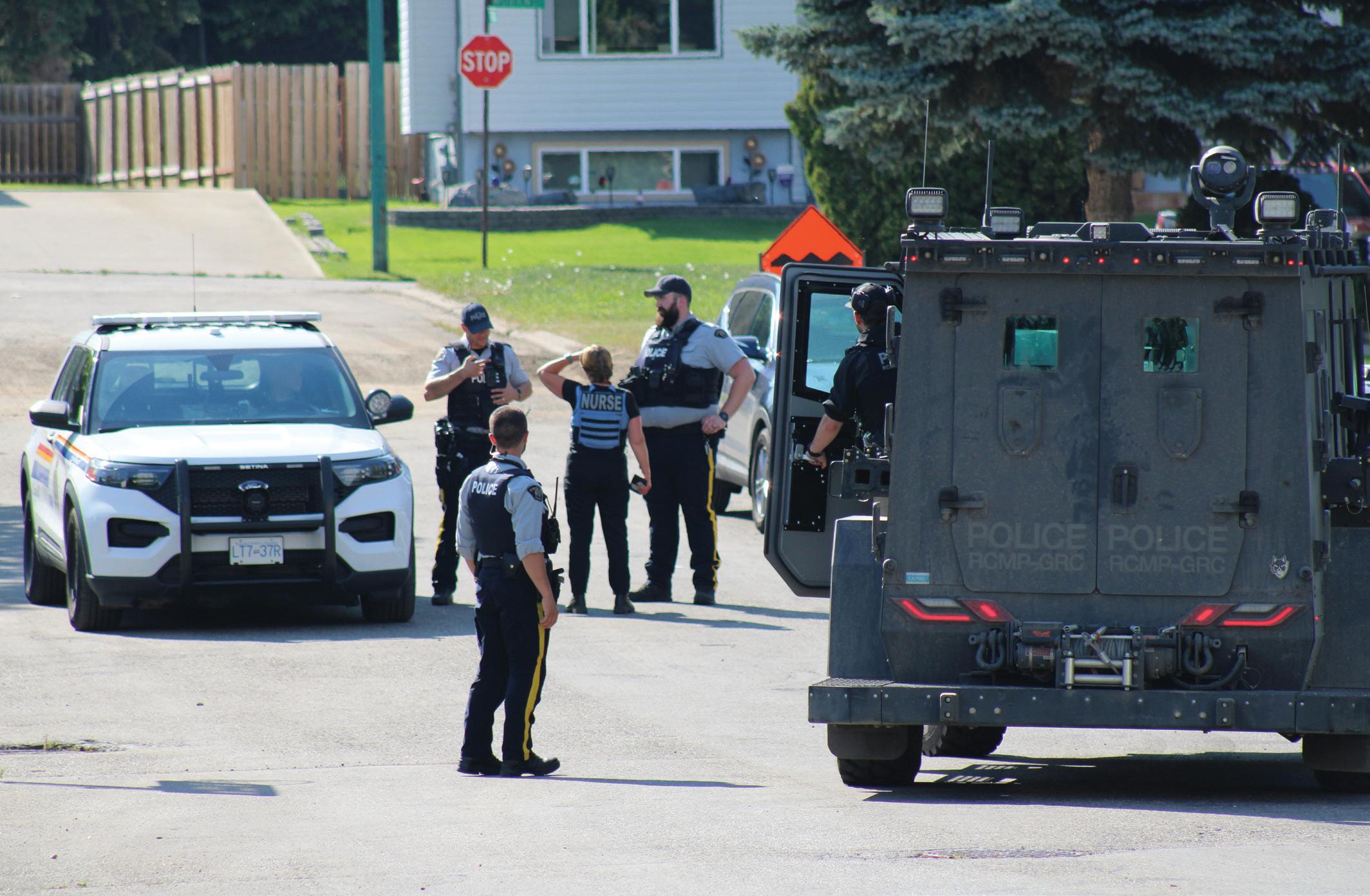
BOB MACKIN Local Journalism Initiative Reporter
A 35-year-old man who pleaded guilty Wednesday, July 30 to dangerous driving, driving while prohibited and obstructing a police officer more than two years ago was sentenced to another four months in jail.
But a judge in Prince George Provincial Court conceded Michael David Trosky would likely serve less time.
Court heard that officers from the Uniformed Gang Enforcement Team apprehended Trosky and two others after an intermittent chase on March 9, 2023.
Trosky had been driving a green Audi that the officers noticed near the North Star Hotel. When the vehicle ended up in a snowpack by a gas station and fast food restaurant near the Hart Highway, Trosky and the other two refused orders to exit the vehicle. Officers broke the windows and pulled them out.

Trosky, who has seven aliases, according to the online court file, initially gave police a false name. But an officer found his identification in the vehicle, along with drugs, cash, a knife and three mobile phones.
Trosky was in breach of an Alberta release order and driving prohibition at the time.
Court heard that he has 37 convictions, including eight for driving while prohibited or disqualified, three for dangerous driving and three for obstruction.
BOB MACKIN Local Journalism Initiative Reporter
A Fort St. John man who bought a used Audi on Facebook Marketplace in February 2024 from an Albertan is entitled to $600 in damages after the seller misrepresented the condition of the car.
In a July 29 Civil Resolution Tribunal (CRT) decision, vice-chair Eric Regehr said Christopher J. Staverman bought a 2005 Audi A4 for $800 from Niall Douglas Campbell to recycle its parts, especially the doors.
Before they agreed, Staverman and Campbell discussed having a friend of Campbell’s take photos of the car. Campbell ultimately said he was unable to do so. Staverman bought the car anyway.
When Staverman picked up the broken down car in Tumbler Ridge, where it was stored at a friend of Campbell’s,
he found the doors rusty and unusable, despite what Campbell had told him.
He filed a CRT claim for $700 for partial refund and the cost of picking the car up.
Regehr found that Staverman proved Campbell negligently represented the car’s condition. Campbell had unsuccessfully argued that he sold the car “as-is.” There was no evidence that he ever said so.
Regehr said Staverman did not provide evidence to support the $400 claim for picking up the car, but said it was obvious that driving a truck for four hours would use a “considerable amount of gas” and awarded $300. Likewise, there was no evidence about the residual value of the car, which was rusty and did not run. So he awarded $300.
Regehr ordered Campbell to pay $600 in damages plus $125 in CRT filing fees.
In an emotional statement, Trosky admitted his crime had been fuelled by drug addiction.
“It’s taken me a long time to actually realize that the things that I’m doing are hurting me, my family, and many people that I don’t even know,” Trosky said in court.
Brecknell said it is time for the Metis man to turn his life around. But he was not certain of his success.
“Either Mr. Trosky is a very good actor or he genuinely, genuinely believes that’s where he wants to go,”
Brecknell said “I accept that’s where he wants to go. The question is, is he going to be able to get there? He’s not going to be able to do it by himself.”
Brecknell sentenced Trosky to 14 months for dangerous driving. He qualified for 393 days of time served credit, leaving 32 days left to serve.
Brecknell also gave him 45 days concurrent for obstructing a police officer and 90 days consecutive for driving while prohibited.
That meant his net sentence is 122 days.
“Do the math, you’ve been in custody before,” Brecknell said near the end of the hearing. “You’ll be out in probably two-and-a-half months.”
After he is freed, Trosky will be on probation for a year. He must complete 30 hours of community work service, attend treatment as directed by a probation officer, must not occupy the driver’s seat of any vehicle and is banned from driving for three years.

Her sentencing was delayed; she remains in custody
BOB MACKIN Local Journalism Initiative Reporter
Provincial Court judge postponed sentencing of a woman after she pleaded guilty July 29 to assault with a weapon and breaching a probation order by having a knife.
Shenoa Rose Thomas, 22, was arrested after stabbing a man at the front desk of the Mark’s Place Shelter before 5 p.m. on New Year’s Day. Thomas, who was also charged with assault causing bodily harm, remains in custody.
Court heard that Thomas had been asked by the man working at the front desk, a refugee from Nigeria, to leave because she had broken the rules by smoking in her room.
Thomas left, but returned a few hours later with a knife that she concealed. She proceeded to stab the man in the top of the shoulder. Luckily, his quick reaction left him with a minor injury.
Crown prosecutor Tyson Gamble proposed a two-year sentence followed by 18 months of probation.
Defence lawyer Hayley Friesen said Thomas should get one year in jail. Both jail sentences would have been

A woman who was kicked out of a local shelter for smoking in her room later returned with a knife, court heard.
reduced by credit for time served since Jan. 1.
Judge Michael Brecknell spent the lunch recess deciding whether to reserve decision for a later date or to order further reports.
He came back in the afternoon to announce the latter. Brecknell said he accepts that “Thomas has had
a horrendous background,” but he wanted to know if that was the result of birth trauma or too much drugs. So he ordered Thomas to undergo psychological and psychiatric examinations and set Oct. 21 as her next court date.
“She has indicated on numerous occasions that she has no interest in any sort of treatment, rehabilitative
processes, counselling, anything like that,” Brecknell said.
Brecknell said the pre-sentencing reports, including one about the impact of her Indigenous suffering, were adequate.
He determined he could not impose a fit and proper sentence without an expert report about her mental state and whether she could be treated by therapy or prescriptions. Brecknell also ordered an analysis of Thomas’s risk to reoffend.
Gamble called Thomas’s history, including heroin and crystal meth use at age 12, “sad.”
However, he said. “her record is extremely violent. Short as it may be, it’s some three pages.”
The crimes include theft under $5,000 and arson to an inhabited property in 2021 and a 2022 robbery in Prince George. The arson involved lighting a mattress on fire and covering a smoke alarm.
While in Colony Farm in Port Coquitlam for a mental fitness assessment in 2024, she attacked and assaulted two female psychiatric nurses, one of whom was pregnant.
“If, at the end of the day, all we can do to protect the public is warehouse Ms. Thomas, is two years in jail the adequate amount of time to protect the public?” Brecknell asked. “In other words, why did the Crown arrive at two years plus probation?”
A 46-year-old man who left an angry phone message for a relative will be on probation for two years after pleading guilty to one of three charges of uttering threats to cause death or bodily harm.
In Prince George Provincial Court on July 30, Judge Michael Brecknell agreed to a joint Crown/defence proposal for Wade Allan Barks to serve the suspended sentence. Crown stayed the two other charges.
Brecknell said that Barks “obviously went overboard” during a family dispute over the division of property after the 2023 death of his mother.
Barks had taken a year-and-a-half away from his work as a tree-feller to be her caregiver and was suffering financial stress.
On July 30, 2024, Barks was arrested at the Prince George RCMP detachment and released on an undertaking after complaints that he had left threatening, expletive-laden voice mail messages on July 21, 2024.
On one of the messages, Barks demanded his rifles and hunting licence be returned or he would “bring 10 guys there” to get them back. He also threatened to bury a relative “low down in the ground.”
Rather than threatening his relatives, Brecknell said Barks should have asked for the items to be returned or else he would ask the police to intervene.
“He recognizes that his behaviour was inappropriate and is taking full responsibility,” said defence lawyer Kimi Aimetz.
Brecknell said Barks is “not the only person to stand by a parent while their parent was suffering and then to get ripped-off by their siblings. Unfortunately, it happens more often than not.”
The probation conditions include an order to stay away from and not contact certain relatives.
Barks must also attend a counselling program as recommended by his probation officer. He cannot possess any firearm, except for his protection at the worksite.
BOB MACKIN Local Journalism Initiative Reporter
A 32-year-old man pleaded guilty July 28 in Prince George Provincial Court to interfering with lawful enjoyment of property, theft of a snowblower and assaulting a peace officer late last year.
Jacob Johan Vanderminne had been charged with break and enter to a dwelling, but pleaded guilty to the lesser charge before Judge Martin Nadon. Nadon agreed to the joint Crown/ defence sentencing proposal of eight months time served and two years probation.
Vanderminne was also ordered to stay away from a residence on McGill Crescent and not contact the victims or people who intervened. He must not possess weapons or break and enter tools.
Court heard that, on Dec. 9, 2024, at 10:53 p.m., Prince George RCMP received a report of a break-in at a

A Prince George judge recently sentenced a man who assaulted a police officer after being caught with a stolen snowblower.
McGill Crescent address where a caucasian male in his 30s was trying to get into a woman’s home while she was there.
An officer found a man pushing a red and black snowblower on the sidewalk and told him he was under arrest, but a struggle ensued.
Vanderminne tried to pull his arm away and said he was not under arrest before punching the officer in the
BOB MACKIN
Local Journalism Initiative Reporter
Charges of possessing stolen property under $5,000 and fraud under $5,000 were stayed July 28 in Provincial Court in Prince George.
The case of Cody Kenneth Matthew Willier, born in 1995, had dragged on for nearly five years.
Crown prosecutor Lisa Sukkau did not provide the reason for the stay to Judge Martin Nadon.
Generally, the Crown proceeds with cases only if there is a substantial likelihood of conviction and, if
so, whether public interest requires prosecution.
The two charges against Willier stemmed from an incident on Sept. 25, 2020 in Prince George.
In May 2021, a warrant was sought for Willier’s arrest and he was charged in November 2021 with failing to appear, for which he was convicted in January of this year.
In July 2024, the Crown approved another charge, for breach of release order.
A 2016 Supreme Court of Canada ruling on the constitutional right to a timely trial set 18 months, from charge to end of trial, as the presumptive ceiling for a case in Provincial Court.
The ceiling for trials in Superior Court (Supreme Court in BC), as established in R. v. Jordan, is 20 months.
mouth.
He got free, but the officer continued to grip his sweater.
Three members of the public assisted her.
After Vanderminne was handcuffed, he initially said his name was “Brandon Bannerman,” but an officer confirmed his true identity in the Police Records Information Management Environment (PRIME) database.
Vanderminne’s defence lawyer Ervin Ariaee told Nadon that his client was diagnosed with schizophrenia and bipolar disorder and has struggled with fentanyl addiction.
On May 5, Judge David Simpkin sentenced Vanderminne to 60 days time served and one-year probation for shoplifting in 2024 at a Lululemon in Vancouver and London Drugs in Prince George, as well as two breaches of probation orders.
Vanderminne was released from custody on bail June 18 to a treatment facility in the Lower Mainland. Court heard that he has been sober for 10 months and is on medication to treat opiate withdrawals.
Ariaee said his client has Indigenous background from his mother’s side of the family, but “he’s not quite sure of the band’s name.”
“He does have plans in the future to connect with it, once he gets his life a bit more stabilized,” Ariaee said.

COLIN SLARK Citizen Staff
In July, the District of Mackenzie got something it had never before experienced in the almost 60 years since it was incorporated — transit service.
On July 15, Mackenzie Community Services and Kimta Transportation Society began offering twice-weekly bus service on Tuesday and Thursday.
Kimta already owned an accessible bus with a chair lift that it runs as a charter for special trips as well as a minivan used for shuttle service from Mackenzie to Prince George Airport and back five days a week.
Jacqueline McCulloch — the Better at Home Program co-ordinator for Mackenzie Community Services — said that the introduction of the bus route came out of a desire to help seniors navigate the community.
Back in February, she said, Mackenzie lost its only taxi after the driver couldn’t make ends meet. Mackenzie Community Services provided vouchers to many of its Better at Home clients to help them afford using the taxi.
For people with mobility issues and without access to a vehicle, the loss of the taxi made it more difficult to buy groceries, pick up prescriptions and attend medical appointments.
Attending the National Community-Based Senior Sector Summit in Ottawa and its provincial equivalent in Vancouver last year, McCulloch said she found out that Mackenzie is considered a transportation desert.
When the United Way started the most recent edition of its Aging in Motion grant program earlier this year, McCulloch said she jumped at the chance to have Mackenzie benefit from it.
She was able to secure a year’s worth of funding for the program and they can reapply for a second year.
“It just became opportune for us to be able to do what we did when we did,” she said. “It’s hard, because districts don’t appear to want to invest time and energy. Like, Mackenzie’s had this shortfall for taxes and so property taxes are going up for everybody.”
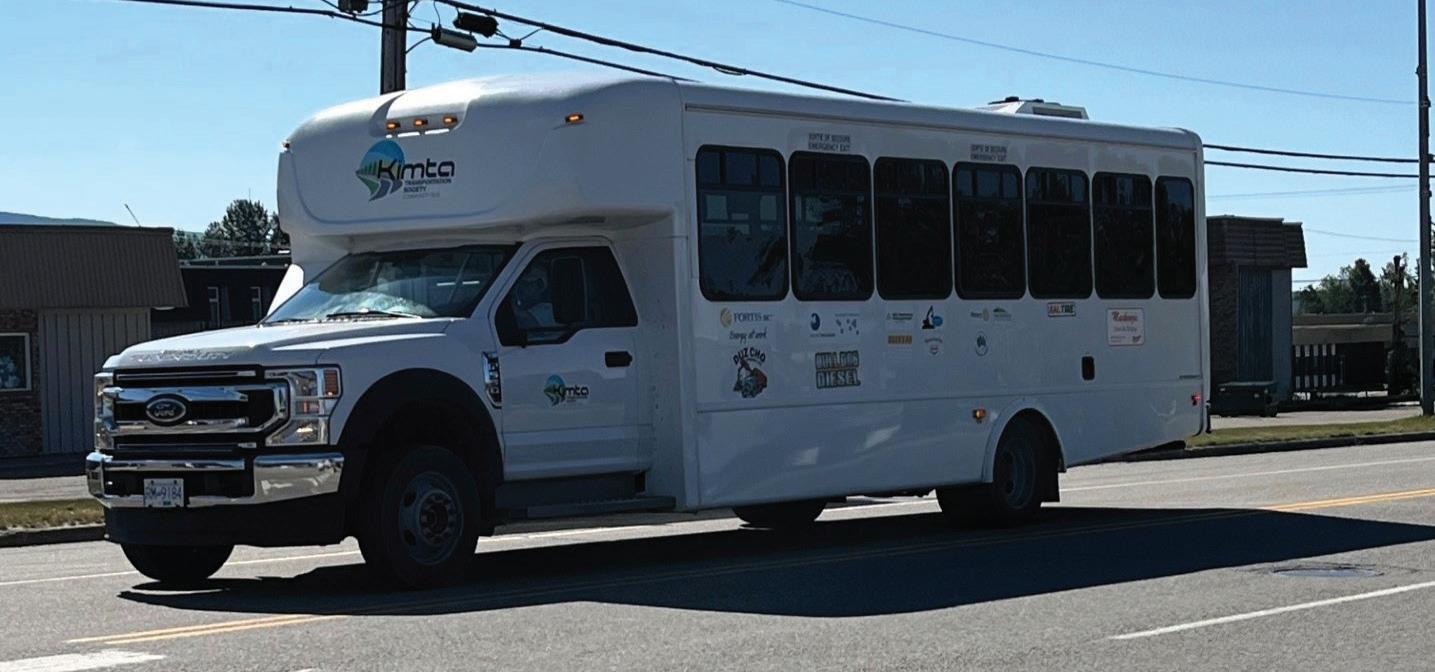
Ahead of the bus service starting up, McCulloch said she went to the Mackenzie Mall and to seniors’ lunches to get feedback on how the service should be run.
“I’ve talked to people who’ve lived here since Mackenzie was formed,” McCulloch said. “They’re just in awe. They’re like ‘you can’t be serious.’”
Since another seniors’ group operates a shuttle to the hospital on Wednesdays, they decided to run the bus on Tuesdays and Thursdays. However, the scheduled will need to be adjusted occasionally when Kimta has other clients or trips already booked.
The bus runs four loops around the community each day, twice in the morning and twice in the afternoon with a roughly one-hour break from 11 a.m. to noon.
Mark Robillard, the president of Kimta, sat down with The Citizen during a visit to Prince George on Thursday, July 30.
He said he got involved with the society about a dozen years ago when he was asked if he would volunteer for the board and soon found out after accepting that he had been named president.
The name of the organization, he said, comes from a mountain north of Mackenzie.
The genesis of the society came when School District 57 outsourced its school
bus operations to an outside company.
Instead of finding a driver and paying gas to use a bus already located locally, school groups then had to get someone from the contractor to come up the night before with a bus and pay for their accommodation and meals beyond any other operating expenses.
The cost to do so was more than $2,000.
“A school doesn’t have very much money in their travel budget, so school teams would have to fundraise for a whole semester to raise enough money to rent a bus to go to zones,” Robillard said.
“But they haven’t had any practice games against any of the competition, so they get slaughtered and nobody wants to go to practice for four months to go to one tournament and get beat up.”
It also meant that kids couldn’t go on trips to Jasper, Mt. Robson or Powder King, the type of events that Robillard and his classmates got to go on when he was a high schooler in Mackenzie. So, the society set out to collect funds to buy a bus for the community’s use. At first, they started out with bake sales, dances and the like, but they didn’t make a lot of money. With the decline of industry in Mackenzie, there also weren’t a lot of businesses left to donate
towards the cause.
Eventually they turned to applying for grants.
Originally, the fundraising target was around $80,000. That would purchase a bus made on a Ford F-350 frame.
The summer they reached their target, Transport Canada added the requirement for three-point harnesses in buses, which added to the weight of the vehicle. That meant they needed to step up to a more expensive Ford F-450 frame, which nearly doubled the price tag.
After eight to 10 years of fundraising, they finally were able to buy the vehicle that met their needs. Robillard estimates that for school groups, the cost of using the Kimta bus for a trip is about one-fifth of what it used to be.
He said during the school year, the bus probably takes two trips to Prince George per month.
Apart from students, there are seniors’ groups who also rent the bus. When the Regional District of Fraser-Fort George’s board of directors went to Mackenzie for its June board meeting, the Kimta bus was used to take them on a tour that included a jaunt out to Powder King.
It’s also found use from the McLeod Lake Indian Band, which Robillard said hired out the shuttle to take elders to Edmonton when Pope Francis visited Canada in 2022 among other events.
Complementing the bus service is the shuttle, which travels from Mackenzie to Prince George and back five times a week, also stopping at Bear Lake, McLeod Lake and Summit Lake if there are people to pick up or drop off along the way.
Robillard estimated that about half the people who take a $55 trip on the Toyota Sienna hybrid minivan use it to get to medical appointments while the others are looking to get to the Prince George airport.
“We’re helping Mackenzie be less isolated,” Robillard said.
“Another way to say it would be that we’re really improving the quality of life for a certain segment of the population. If they can’t drive, they can get to Prince George to see a specialist, they can see a dentist, they can see an optometrist because none of these things are in Mackenzie. For a certain segment of the population, they were foregoing all of that.”
When McCulloch approved Kimta about the fixed-route service, Robillard said he thought it was a good idea, also referencing the end of local taxi services in town earlier this year.
He said while there hasn’t been heavy use of the route yet, there’s hope that numbers will increase heading into the fall as awareness of the service grows. Both Robillard and McCulloch said they expect more passengers in the winter, especially among people with mobility issues.
The bus can handle up to 24 passengers at one time and has room for up to four wheelchairs.
However, Robillard doesn’t think the current bus is the right tool for the fixedroute service. Because of the size, it eats up a lot of gas driving around town.
Because of that, Kimta is looking for more grants and donations to help it purchase something smaller than its current bus and bigger than its minivan.
Those looking to donate to Kimta or arrange transportation can reach the society by email at kimtatransportation@gmail.com.
Details can also be found online at mackenziebc.com/kimta or the Kimta Transportation Society Facebook page.
During the first week of operations, McCulloch said a Kimta board member rode the bus to see how things were going. Through seeing it firsthand and conferring with passengers, some adjustments were made.
She said they don’t want to constantly change routes from one week to the next, but over time, they’ll put out notices online and through the local radio station about alterations to the schedule.
On McCulloch’s to-do list was to create some laminated sheets showing the morning and afternoon routes and put them up at strategic locations like the Mackenzie Recreation Centre, the pharmacy and the Purple Bicycle coffee shop.
Like Kimta, McCulloch is also looking for donations and grants to help the program running. She can be reached by email at jmcculloch@mymcs.ca.
She said the manager of the local Co-op food store has nominated the program as a recipient from the organization’s annual Fuel Good Day event, where a portion of proceeds from gasoline sales are directed to good causes.
After some difficult decades for Mackenzie, she said she’s glad to be able to give something back to the community.
“It feels incredible,” McCulloch said. “Especially knowing how much our senior population has ballooned. We’re anxious for the next census to come out to tell us exactly how much, but we’re guessing that our population is now at about 3,500 people and we’re at about 35 per cent seniors.”

11 a.m. to 3 p.m. on Friday, Aug. 8 and
day, Aug. 29.




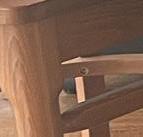




























































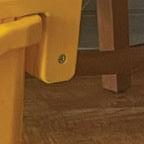





































BOB MACKIN Local Journalism Initiative Reporter
The vice-chair of the Civil Resolution Tribunal (CRT) ordered the Dawson Creek Volleyball Club (DCVC) to hold a new vote on bylaw amendments to stagger board of directors elections and increase the number of directors.
Members Jean Paul Legault, Natasha Legault, Alexis Legault, Wesley Pearson, Todd Mingo and Brandi Noordhoff had accused DCVC of giving inadequate notice on Facebook for two general
meetings in 2024. They sought an order to rescind the bylaw amendment and redo the election for directors. They also accused the board of failing to provide records under the Societies Act.
DCVC claimed it gave adequate notice for meetings, even if they did not “technically comply” with the Societies Act.
Members voted Aug. 22, 2024 to amend bylaws to replace annual elections with staggered, two-year terms for directors. They also moved to increase the board from nine to 11 members and replace the risk management position
with a director of fundraising. On Sept. 10, 2024, at another general meeting, members elected the new board.
Regehr agreed that the bylaw amendments are invalid and the directors elected are only to serve one-year terms. But he declined to order a new election.
“It would be impractical and largely pointless to run a new election now because the directors’ terms will soon expire anyway.”
He also declined to rescind the bylaw amendments, “because doing so would ignore the will of the members who
voted at the August meeting. Rather, I find it appropriate to require the DCVC to hold a revote on the bylaw amendments.”
Regehr also ordered DCVC, within 14 days of the decision, to provide Jean Paul Legault the register of directors and register of members, including contact information, plus minutes from the general meetings in question and minutes from directors’ meetings between January and September 2024.
He also ordered DCVC to pay $225 in CRT fees.
Meeting to discuss bullying and racism goes ahead despite Lisa Bear’s no-show
ANDIE MOLLINS Local Journalism Initiative Reporter
British Columbia’s Minister of Education and Child Care Lisa Beare was absent from a meeting she was invited to attend Wednesday, July 30 in Esk’et (Alkali Lake) near Williams Lake.
Just days before the in-community meeting planned by Esk’etemc to discuss concerns around bullying and racism in School District 27 (SD27), Beare postponed her visit to Esk’et for reasons which the ministry did not say.
“My team is working closely with the Esk’etemc First Nation leadership and School District 27 to explore ways to advance student success in the district from a place of collaboration and shared understanding,” Beare wrote in a statement to the Tribune. “I remain committed to supporting local leadership, building trust and moving forward, government to government.”
The ministry said a meeting with Esk’etemc would be rescheduled to a later date.
The superintendent and board trustees of SD27, which instructs 4,600
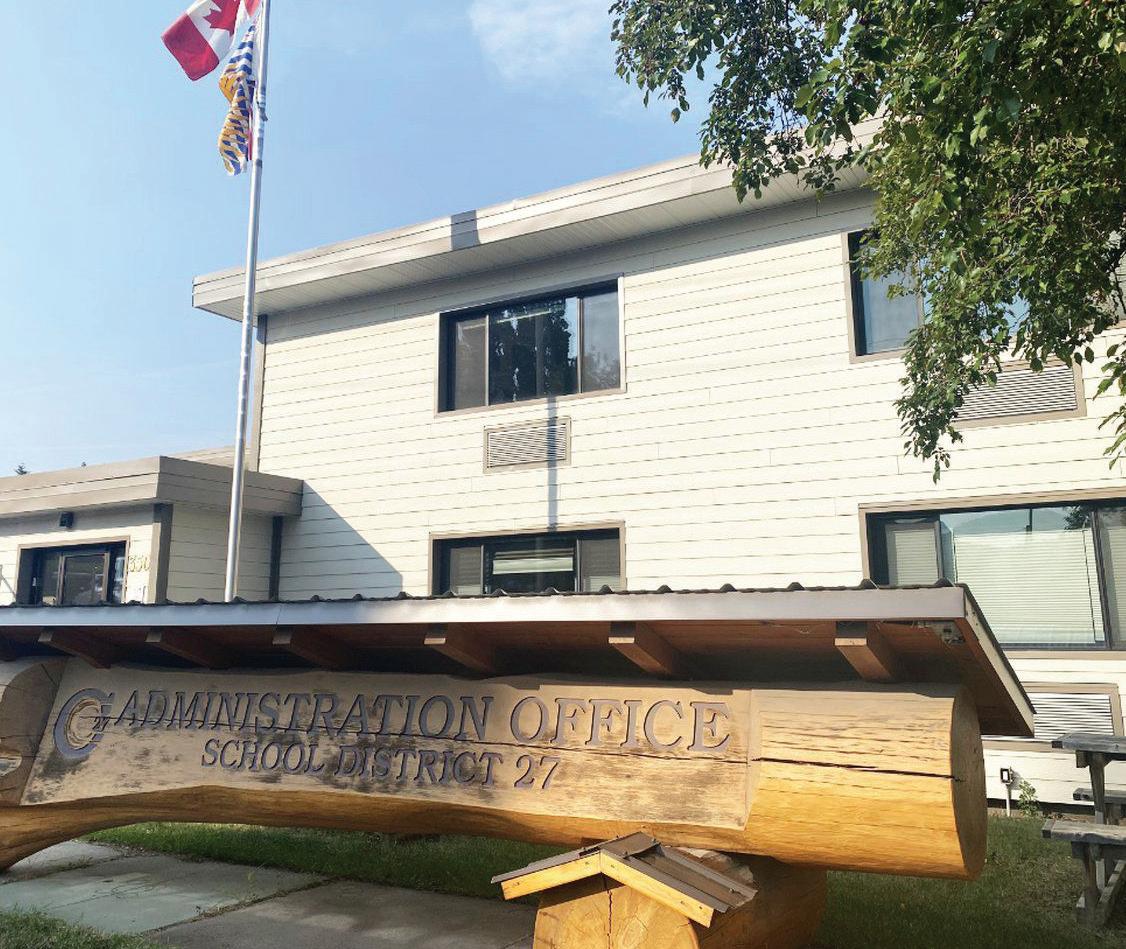
Community members concerned about bullying and racism in SD 27 were expecting a visit from Minister Lisa Beare on Wednesday, July 30 and went ahead with the meeting despite her postponement.
students across 22 schools in the Cariboo Chilcotin region, were also invited to attend the minister’s visit.
“That visit is not happening at this time. We will continue to focus on our work with Esk’etemc through the Indigenous Education Council and our Local Education Agreement team, and planning
around the recommendations from the School Community Culture and Climate Review ordered by the Minister and completed by Safer Schools Together,” wrote Cheryl Lenardon, superintedent of SD27, in a statement to The Tribune.
The review was ordered by the minister in the fall of 2024 and a summary
of the findings became available in late spring 2025 after which Beare directed the school district act on its recommendations.
Beare’s planned visit to Esk’et was the result of a unified request for her presence by Esk’etemc Kukpi7 (Chief) Fred Robbins, Grand Chief Stewart Phillip from the Union of British Columbia Indian Chiefs (UBCIC) and by a then representative of Concerned Parents and Caregivers of Williams Lake (CPWL), all of whom planned to attend. An invitation was formally sent to the minister on April 14 and the date of July 30 was later agreed upon for the visit.
While she could not attend, Beare said her door remains open for discussion to ensure all students have access to a welcoming and inclusive learning environment.
The purpose of the meeting was to share with the minister first-hand accounts of racism and bullying in SD27 and drive home Esk’etemc and CPWL’s unified demand for an investigation in the school district.
Each has collected full binders of testimonies which cause them to claim there is an urgent crisis in SD27.
Esk’etemc went ahead with the meeting despite the minister’s absence and plans to share a statement in the coming days.
This story originally appeared in The Williams Lake Tribune.
ABIGAIL POPPLE Local Journalism Initiative Reporter
The BC Wildfire Service (BCWS) has countless tools in its firefighting arsenal, from aerial crews to bulldozers. But sometimes, a good defence requires a strong offence — controlled ignitions, where BCWS intentionally ignites fires to use up fuels, are one such case.
While seemingly counterintuitive, the strategy can help control bigger fires, and in early July was used on a wildfire near the east shore of Kinbasket Lake, said BCWS Information Officer Pedro Roldan-Delgado.
“Because the terrain (of the Kinbasket fire) was extremely steep, it would be unsafe for our crew members to actually action the fire,” Roldan-Delgado told The Goat in an interview. “We did an ignition to make sure it wouldn’t spread further than where our planned ignition was — we didn’t want it to grow south, east and west.”
The ignition allowed BCWS to control the spread of the fire by establishing control lines — wide dirt paths where fuel is removed from the ground with bulldozers or shovels — around the planned ignition.
According to Roldan-Delgado, rocky mountainsides with little fuel provided a natural control line at the Kinbasket fire,

BC Wildfire Service pontoon planes, which can collect lake water and dump it on active fires, operates on Tzenzaicut Lake on Friday, Aug. 1 near Quesnel. The service also uses controlled ignitions and other methods to fight fires.
so BCWS carried out a planned ignition to burn up remaining fuel between the fire’s natural perimeter and that control line.
“There’s a lot that goes through to plan these ignitions,” he added. “It’s only carried through with skilled, experienced firefighters utilizing fire and weather information to support our decision making on the timing and scale of the planned ignition.”
Ground crews and specialized
firefighters communicate with the local fire centre to make these decisions, Roldan-Delgado said. They consider factors like wind and precipitation — if it’s very hot and dry, a planned ignition is too risky, so BCWS will wait for safer conditions, he said.
The Prince George Fire Centre currently has a ban prohibiting fires bigger than half a meter wide and half a meter tall. People stoking campfires should clear fuel and debris near the campfire’s
edge and hold off on having a fire if it’s windy, Roldan-Delgado said.
With thunderstorms rolling through the Prince George Fire Centre, Roldan-Delgado reminds residents to report fires to BCWS by dialing *5555 or 1-800-663-5555.
“Always assume we’re not aware of it, give us a call, and report the wildfire,” he said.
This article originally appeared in The Rocky Mountain Goat.
ABIGAIL POPPLE
Local Journalism Initiative Reporter
Valemount will need 119 housing units to accommodate population growth over the next five years, according to projections from Langley-based company MVH Urban Planning and Design. President of the company, Michael von Hausen, and Senior Planner Jonathan Schmidt presented their findings to Valemount council on July 10.
Under BC housing legislation, municipalities must adopt a Housing Needs Report every five years, which include projections for housing needs over the
next five and 20 years. Additionally, municipalities must have an Official Community Plan (OCP) which includes housing planning policies.
The province is requiring that OCPs are updated by the end of 2025 to ensure five- and 20-year housing needs are included in the plans.
According to von Hausen, Valemount has enough vacant land to build the required 119 new units in five years, as well as the estimated 324 units in 20 years.
“You’ve got more than enough land and capacity to fill the housing needs,” he said. “There’s no problem there. In fact, it’s an opportunity.”
He added that because Valemount’s vacant lots would be serviced by the village’s water and sewage systems, building housing on that land would generate more tax revenue for the village. However, the village should make sure new housing addresses local demographics that currently struggle to find housing — seniors and seasonal workers, according to von Hausen.
Expanding the electricity grid to accommodate more housing units could be difficult, said Mayor Owen Torgerson.
“We have the infrastructure on the ground to support densification … but
(not) without significant upgrades to our inflow of electricity,” Torgerson said. “I don’t think the province and Ministry of Housing put power into their needs assessment for any municipality, and at $10,000 a pole, that’s significant for anybody looking to make a buck as a developer.”
Insufficient power was not a problem for municipalities building more housing until recently, von Hausen said. He suggested researching grant opportunities to cover the cost of building a new power station, if necessary.
This article originally appeared in The Rocky Mountain Goat.


Music at the Pavilion at Lheidli T’enneh Memorial Park goes Thursday, August 7 and 21 from 5:30 to 8 p.m. All artists are family-friendly and part of the Prince George music community. Bring the family and lawn chairs or blankets and come enjoy an evening of music at the park. Don’t forget that the Exploration Place is open until 8 p.m. on Thursdays with admission by donation. There is also Cruisin’ Classics Car Club on site, Origins Kitchen take-out window is open until 8 at Exploration Place and the Little Prince steam engine runs from 3 to 7 p.m.
Harp Concert and Workshop with Scottish Harpist Ailie Robertson goes Saturday, Aug. 9. Experience the power and beauty of the Celtic harp with one of Scotland’s leading harpists and composers. Robertson is renowned for her ability to weave together the rich traditions of Scottish and Irish music with a bold contemporary voice. This unforgettable concert will feature a vibrant blend of traditional Scottish and Irish melodies, reimagined folk tunes and original compositions that push the boundaries of what the Celtic harp can do. Admission is pay-what-you-can. The workshop offers the chance to learn from Robertson who will teach a selection of traditional Scottish tunes, with a focus on technique, ornamentation and style. Cost to participate is $30. Register by Aug. 8 at pgconservatory. ca/calendar.
Kulbir Jhinjer Live goes Saturday, Aug. 9 at 6:30 p.m. at the Prince George Civic Centre. Jhinjer is a prominent Punjabi singer and songwriter known for his distinctive voice and impactful lyrics. He gained recognition with his hit tracks that blend traditional Punjabi music with contemporary sounds For tickets visit www.ticketsnorth.ca/event/ kulbir-jhinjer-live.
Pineview’s Junk in the Trunk goes Saturday, Aug. 9 at the Pineview Recreation Commission, 6470 Bendixon Rd. Everyone is welcome to attend this community garage sale. Call Judy at 250963-9723 to reserve a spot.


In addition to the agricultural exhibits, rides, shows and other entertainment, the BCNE also features plenty of games. it runs Thursday, Aug. 14 to Sunday, Aug. 17.
Hixon’s 44th annual Fall Fair goes Saturday, Aug. 9 and is hosted by the Hixon Community Association featuring a parade, concession, information booths, contests and horticultural event. There is a catered roast beef dinner for $20 each, children are free under six and a show featuring Sara Jones and Dale Ehrstien for $20, free for those under 13. Silent auction and bag raffle. Tickets are at the Hixon Shoppers.
Fire Truck Grand Opening goes Sunday, Aug. 10 at 11 a.m. at 10640 Glenmary Road, the Shell-Glen Community Park. Join the Shell-Glen Improvement Society and co-hosts, Shell-Glen Fire Rescue to celebrate the rehoming of the fire truck that was part of the playground at Lheidli T’enneh Park. This isn’t just a piece of playground equipment, it’s a cherished landmark that holds so many memories for generations. There will be a ribbon cutting then meet local firefighters, and grab a hamburger by donation with all proceeds going to support community improvement projects.
Beginners Pickleball Lessons start Monday, Aug. 11 at Recreation Place and is presented by PG Tennis & Pickleball Club in a four-part series. These are beginner-friendly lessons to learn how to serve, score and rally like a pro all while having a blast. For more information and to register visit www.pgtennisandpickleball.ca/ beginners-lesson-package.
BC Northern Exhibition (BCNE) goes Thursday, Aug. 14 to Sunday, Aug. 17 at the Exhibition Grounds, hosted by the Prince George Agricultural and Historical Association. Along with West Coast Amusements and the Food Court there is a BCNE Trade Route Beer & Cider Festival and a BCNE/Spirit of the North fundraising Casino Night along with main stage performers and roaming acts including SuperDogs, Heritage Lane, Equine Events, 4H displays and showcases and old timey fair contests for Home Arts & Horticulture including woodworking, flowers, quilting, needlework and more. Tickets are free for children 11 and under, youth 12 to 17 are $5, adults 18 to 54 are $10 and 55+
are $5 except for Seniors Day on Aug. 14 and then it’s a toonie for seniors to get into the fair. For all the details visit www.bcne.ca/ and for advanced tickets visit www.showpass.com/s/events/ all/?search_string=bcne.
Big Rig Show & Shine goes Saturday, Aug. 16 noon til dark with a light show after dusk and Sunday, Aug. 17 from 9 a.m. to 2 p.m. at PGARA Speedway. Food trucks on site, music and good vibes, logging trucks, heavy haulers, cranes and more. Bring the family and show your pride in your ride. This is a working truck show so whether your ride is shiny, dirty or just off a haul, be ready to light up the night. Pre-register your truck by emailing htrpilotservices@outlook.com – just $20 to register before Aug. 15 and $25 after. $2 admission for the public.
If you’ve got an event coming up email us at news@pgcitizen.ca to offer details including name of the event, the date, time and location, ticket price and where to get them and a little bit about what’s happening, too. LOCF
There will be 50 exhibits and more as the BCNE’s annual Seniors Day returns to Kin 3 Thursday
CHRISTINE DALGLEISH Citizen Staff
Seniors Fair at the BC Northern Exhibition (BCNE), presented by the Prince George Council of Seniors, goes Thursday, Aug. 14 from 10 a.m. to 3 p.m. in Kin 3.
The Seniors Day admission to the BCNE is only a toonie on Thursday and at the Seniors Fair there will be 50 informative exhibits on display from a variety of seniors-related organizations with free draws and activities.
Fairgoers will be issued passports on which to collect stamps, stickers or initials from every exhibit to ultimately enter a draw for goodies. There will be an opportunity to vote for a favourite exhibitor as well.
The theme of this year’s BCNE is Come And Knock On Our Door, a reference to the theme song of the popular 70s sitcom Three’s Company so Prince George Council of Seniors executive director Malhar Kendurkar said while they host the Seniors Fair staff and board members will be dressed in their retro best.
“So we’ll be in bell bottom pants and all of that,” Kendurkar laughed.
At the Seniors Fair in Kin 3 guests will be able to try out a few activities including the latest fun form of exercise — cardio drumming — led by Shirley Morin from the Spruce Capital Seniors Centre.
“It was a big hit last year and they’ll be doing it again this year,” Kendurkar said.
“We’ll also do some games like corn hole.”
This year after hearing some feedback from last year’s exhibitors, Kendurkar said the Council of Seniors realized that asking them to man their booths from 9 a.m. to 4 p.m., plus the time to

Shirley Morin, left, leads the cardio drumming demonstration at the BCNE Seniors Fair last summer where enthusiastic people joined in the fun.
set up and take down, made for a really long day. So now the event is short and sweet.
“So taking everything into consideration we thought 10 a.m. to 3 p.m. was more reasonable,” Kendurkar said.
Last year there were about 1,300 guests attending the Seniors Fair and about the same number will be expected this year.
Just like last year the Council of Seniors will see lunch provided by Chaa Tayo Bubble Tea and Wings, celebrating flavours of the Philippines. Knowing meals must be budget-friendly the limit is set at $10.
“They are excellent at making the menu really affordable for seniors, which actually helps a lot,” Kendurkar said.
“We’re just happy they’re coming to the fair again this year as they consider this a service to the community, which is really nice.”
And don’t worry, the spice-level will be senior friendly, too, he added.
“Last year it was a big, big hit when it comes to value and this year the Council of Seniors will provide free coffee for all the seniors because that was another request from a lot of seniors last year so we will be offering free coffee to everyone who visits our booth,” Kendurkar said.
“I think it’s important to host the Seniors Fair because we’re not only serving the seniors but partnering with
the organizations to get the information they need. It’s a great way for all the seniors and everyone else to come in and get the information about services important to them while feeling a part of the community at the same time when they come to the fair.”
Anyone looking to donate items as door prizes that will be raffled off at the Seniors Fair can contact Kendurkar at ed@pgcos.ca
Thursday’s entry fee to the BCNE is only a toonie for seniors 55-plus. The BCNE is presented by the Prince George Agricultural and Historical Association that hosted its first fair in 1912, three years before the City of Prince George was incorporated.
all the organizations in the city who will provide a variety of information to the seniors. People can always come to the Council of Seniors Resource Centre but at the BCNE you will get first-hand information from the people who provide the services. Seniors can talk to
The BCNE goes from Thursday, Aug. 14 to Sunday, Aug. 17 at the Prince George Exhibition Grounds.
For all the details including a full schedule of events visit www.bcne.ca/.
See an advance look at the rest of this year’s BCNE on Page 26.
The Prince George Citzen right to your inbox.


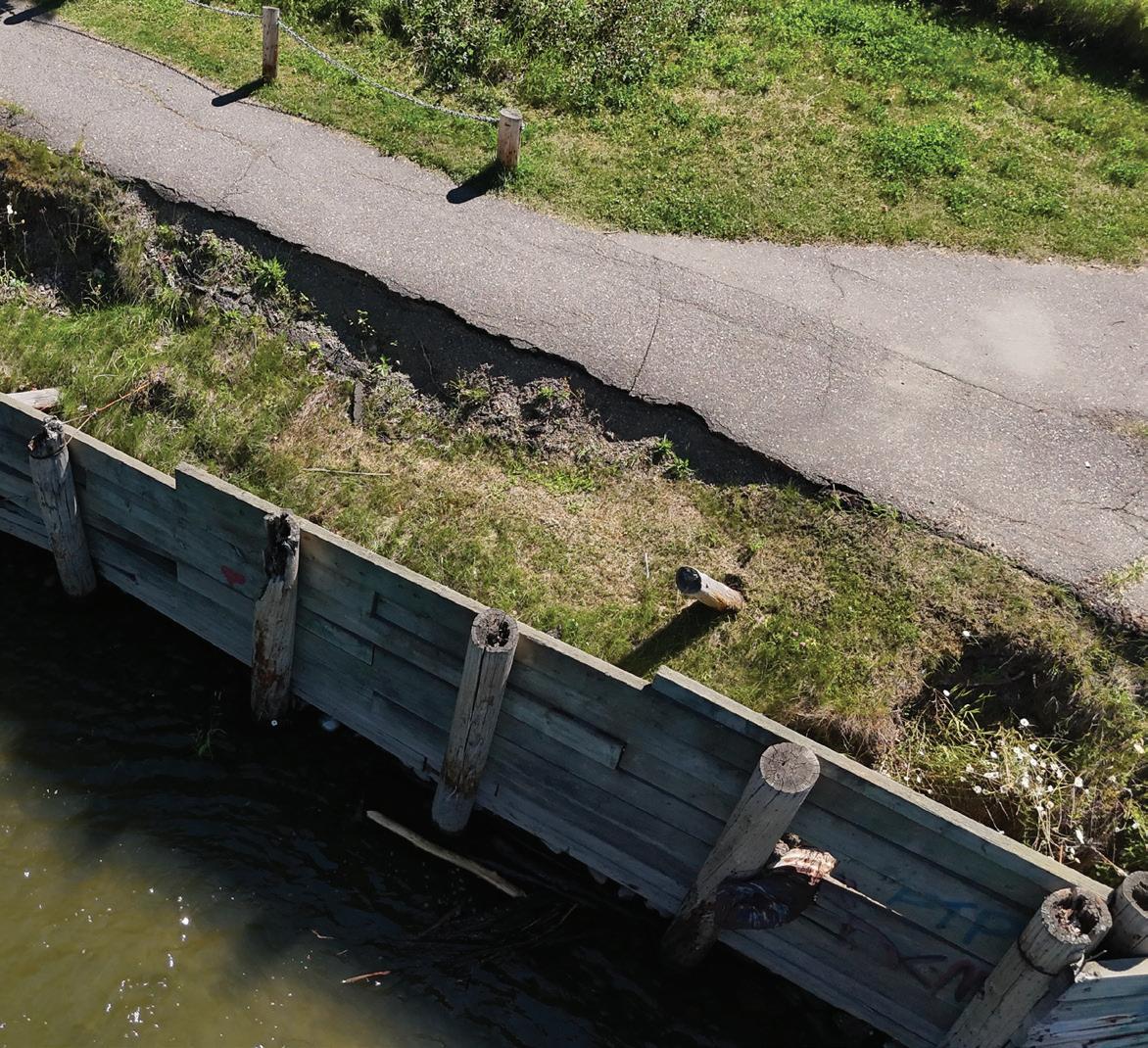
One of the most badly damaged parts of the Heritage River Trail is the stretch between Cottonwood Island Park and the Cameron Street Bridge, where erosion has led to the closure of some sections



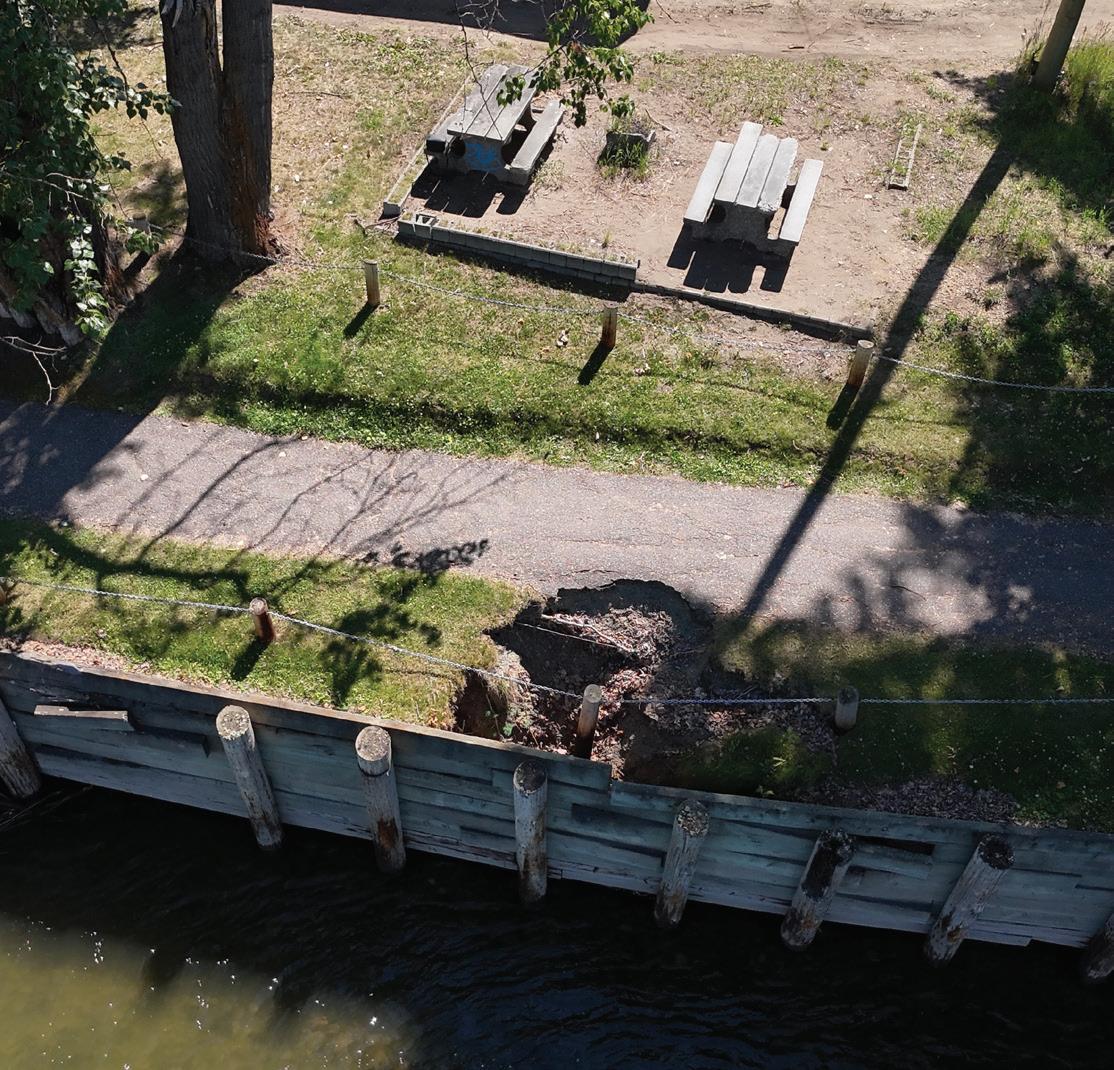
An aerial view of the trail taken in late July offers a look at a part of the trail that is currently closed, with insets showing the extent of some of the erosion damage
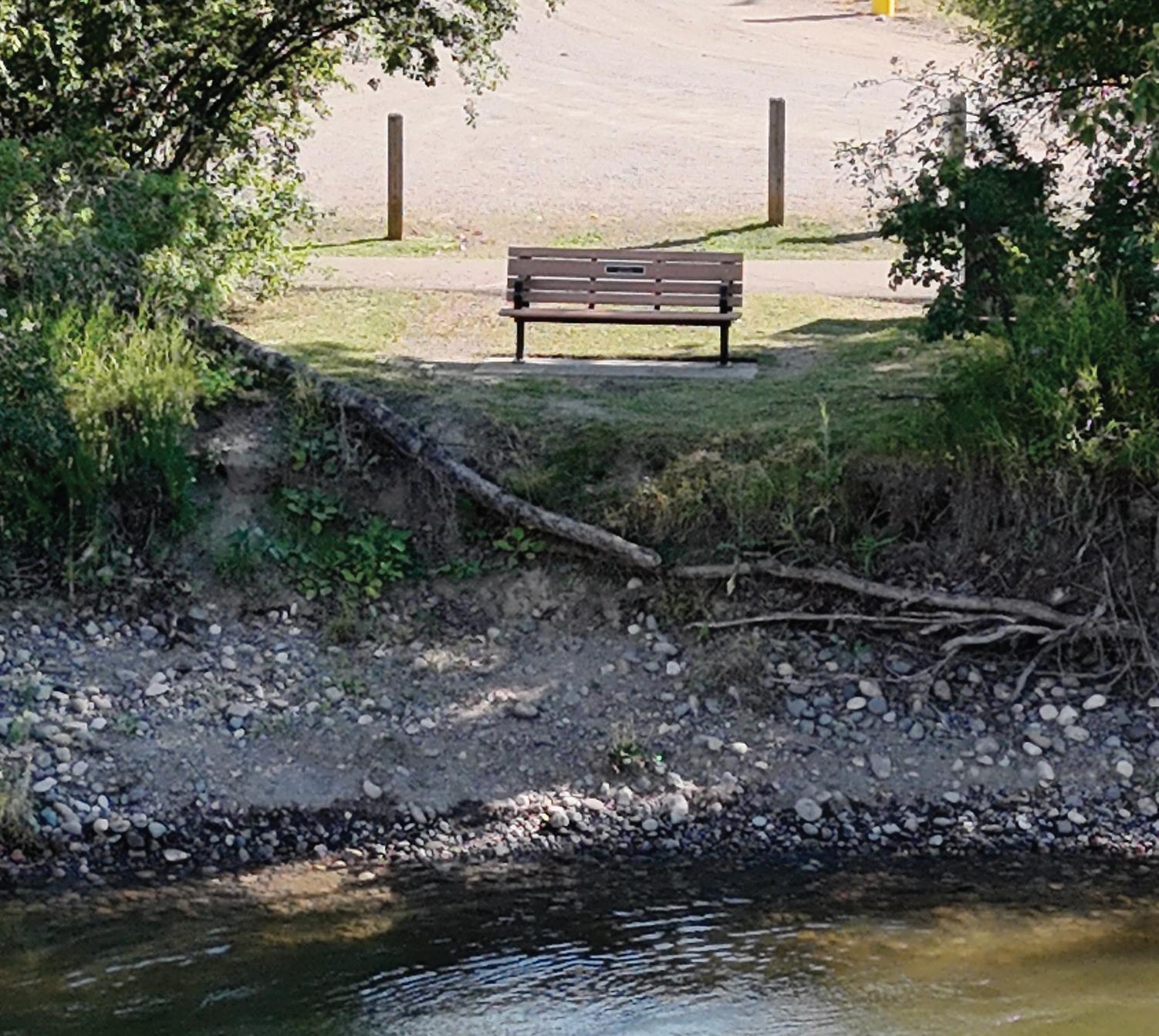
CITIZEN PHOTOS BY MICHAEL KAST
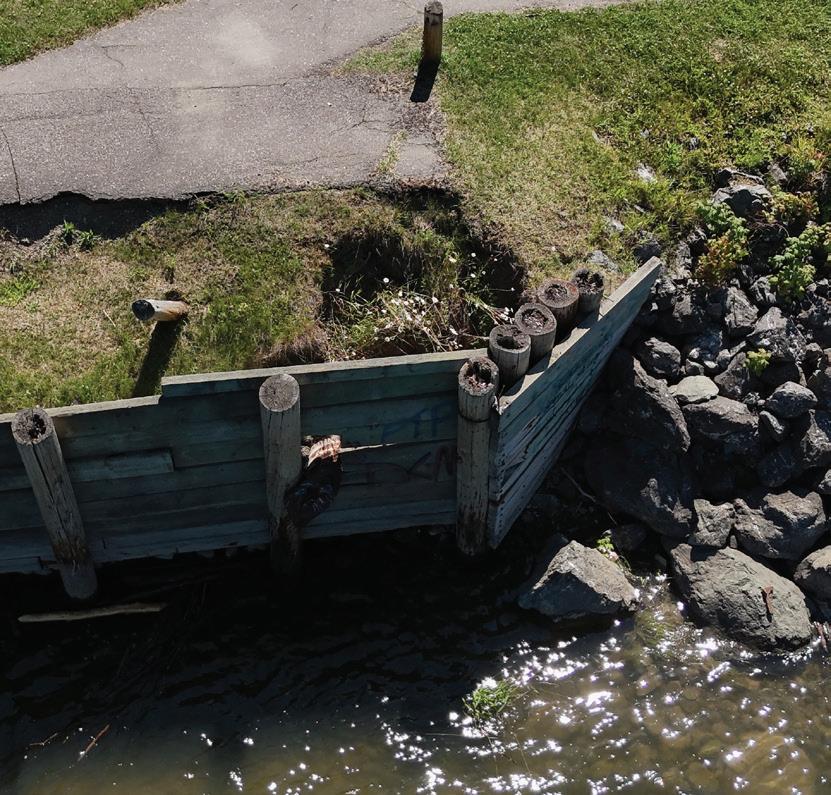
MATTHEW HILLIER Citizen Staff
The exhibition that has been around longer than the city hosting it is set to dazzle attendees for another year
The British Columbia Northern Exhibition (BCNE) takes place from Thursday, Aug. 14 to Sunday, Aug. 17 and is expected to attract an estimated 20,000 locals and regional visitors.
Organizers from the Prince George Agricultural and Historical Association choses Come and Knock on Our Door as this year’s theme, aiming to showcase the agricultural roots that founded the BCNE back in 1912, as well as the hospitality that came with it.
Exhibition Park will be transformed by the BCNE with midway rides, shows, 80 indoor vendors, 15 food trucks, equine competitions and much more.
Amy Heise, president of PGAHA and BCNE, told The Citizen about some new offerings that guests can expect.
“This year we’ve got a caricaturist, which is part of the gate admission,” she said. “It’s free for anybody after you pay to get in, and his name is Ted Kooling. He’s new. We’ve got Clinton Gray back, who’s our magician … and then we’ve got some new horse events out of the ag arena.”
Below is a schedule of the equine events and their times:
Thursday
• 1 p.m. Kid’s Gymkhana
• 6:30 p.m. Barrels
Friday
• Noon: Saddle Up N Sort (will run all day)
Saturday
• 9 a.m. to 5 p.m.: Saddle Up N Sort
• 6 p.m.: Breakaway warm-up
Sunday
• 9 a.m.: Breakaway Finals
• Noon: Team Roping
In addition to equine events, the BCNE is also hosting two dog shows expected to showcase the talents of man’s best friend.
SuperDogs is set to run all four days at the BCNE — at 11 a.m., 1 p.m., 3:30 p.m. and 6 p.m. from Aug. 14 to 16, and at 11 a.m., 1 p.m., 3 p.m. and 4:30 p.m. on Aug. 17.

Jeff and Lisa Vogel take a spin on Fireball at last year’s BCNE. The midway is back this year, along with plenty of other things to see and do.
Running for 40 years and a centrepiece of many agricultural fairs, SuperDogs has made more than a hundred television appearances, with 150 experienced trainers guiding the performances.
“SuperDogs is a dog agility show and they use all rescue dogs,” said Heise. “They travel all over Canada. We’ve had them for six years now and they’re super popular. Everybody loves to see the SuperDogs — of course, they are a part of the gate admission. So once you pay your gate, besides the rides and the food, anything else in here is covered. It’s super popular, the stands are always full.”
SuperDogs isn’t the only event featuring canine talent; the BCNE is also offering stock dog demonstrations on Aug. 14 at 11:30 a.m., 1:30 p.m., 4 p.m. and 6:30 p.m.
The BCNE is also partnering with Spirit of the North to offer a casino night to raise funds for both organizations.
The casino night will take place during the BCNE Ale Festival on the Friday night of the exhibition. Tickets are currently on sale online at the BCNE website, www.bcne.ca.
Heise was also excited to share a unique contest coming to the Ale Festival.
“There’s a movement, and it’s a big movement. What people are doing is what is called a Mrs. Roper Romp,” said

Heise. “You dress up in your best Mrs. Roper costume from the sitcom Three’s Company. Think red curly hair and bright-coloured costumes, and then they do pub crawls and things like that. So on Saturday night, we are having a Mrs. Roper Romp in our Ale Festival.”
Tickets to casino night also include gate admission and five tasters from the breweries and cideries at the BCNE. Funds from ticket sales will be split 50/50 between the two organizations.
With the BCNE being one of the North’s longest-running events, it’s only natural that the exhibition would showcase its roots.
Heritage Lane will feature old-fashioned trades, skills and live demonstrations. Guests will have an opportunity to explore old Fort George and learn more about the pioneers and mavericks who helped found the city.
Heise told The Citizen what guests can expect during their visit to Heritage Lane this year.
“We brought a whole little village of buildings,” said Heise. “It’s just beside where gymnastics is, and Huble Homestead has a booth in there — the Spinners and Weavers, the Railway Museum,
Barry the Blacksmith, the Beekeepers Association, the Métis Association. It’s really just going back to our roots and offering display areas.”
Of course, the BCNE wouldn’t be complete without roaming performers and some electrifying Main Stage acts. While the full schedule isn’t available yet, Heise offered some early hints at what guests can expect.
“We’ve got the Legends Live group that does the Elton John impersonator and others — they’re going to be in our Ale Fest on Friday night,” said Heise. “As well, Corey from Legends Live is going to be doing his Elton John and being our MC for our main stage. Then on Saturday in the beer group, we’ve got Appaloosa Band playing our main stage, and we’ve got lots of local acts, like Chris Godwin and Rick Stavely.”
Despite all the high-energy attractions and performances, Heise said her favourite part of the BCNE is the 4-H club, which has been a core part of the exhibition since the 1930s.
“Because they get exposed to animals they don’t see all the time, and their little faces are so excited to see bunnies and chickens and even the cows,” she said. “It’s a very exciting time for them and that’s really my favourite part.”
Heise also wanted to emphasize that this is an event for everyone in the region.
“I hope that they know that our group of volunteers is doing our best to make BCNE something that’s affordable, and that there’s something for everyone,” said Heise. “We want to make sure that you’re entertained the whole time you’re here. Maybe you don’t want to shop, maybe you want to look at horses, maybe you really want to go look at the bunnies, maybe you just want to ride the wagon — there’s lots of stuff to do, and $10 gets you a multitude of things. So if you want to come and have a cheap day and you aren’t a ride guy, or you don’t want to buy food here — $10 gets you a ton of different things to do and you don’t have to pay any extra once you get in!”
Visit www.bcne.ca to learn more.
CHRISTINE DALGLEISH Citizen Staff
#RevivetheRelay is the hashtag that will soon be a social media trend in Prince George when word spreads that three UNBC students have taken up the challenge to restart the 24-Hour Relay for Life in 2026, which was killed off by the pandemic.
In its heyday, Prince George’s 24-Hour Relay for Life, a mega-fundraising event for the Canadian Cancer Society, was ranked No. 1 in the country four years running, reaching its crescendo in 2017 with more than $500,000 raised locally.
Ready to resurrect the Relay for Life to its former glory are Victoria Bleecker, first-year student in the Northern Medical Program, Maleen Barry, registered nurse (oncology) who studied at UNBC, and Zoe Younghusband, fourth-year nursing student, who is looking to enter the Northern Medical program.
Having lost a grandma and grandpa to cancer, Younghusband, taking on site lead duties for the event, said she knows so many people have been touched by cancer and acknowledges the 24-Hour Relay for Life was always a popular event that meant so much to the people of Prince George.
“I know there are so many people who are eager for the 24-Hour Relay for Life to come back,” Younghusband said, calling it a passion project for her friends.
“Victoria and I have worked collaboratively many times before on different projects and when Victoria asked me to be site lead on the project I knew I wanted to support her and the project in whatever way I could to help bring it back to the community,” she said. “So far it’s been really rewarding and I am super-stoked to bring it back to Prince George. I think it’s been a well-loved and very missed event in our community.”
In 2023 the fundraising event was cancelled and it never really came back after that except for smaller versions, mostly at high schools, she added.
Once Masich Place Stadium, where the event was held for years, had an artificial turf installed, the Relay for Life

was moved to Exhibition Park in 2018 because the infield at Masich couldn’t have tents pitched on it.
The relay wasn’t the same at that location because people were so spread out.
In 2020 and 2021 the fundraiser was cancelled because of the pandemic. In 2022 it was reduced to a shadow of its former self, re-imagined as a six-hour walk at the track at Ecole Lac Des Bois, but it was cancelled at the last minute due to high winds.
In 2023 it was cancelled outright, citing lack of volunteers and participants as the reason for its demise.
MP Todd Doherty did the 24-Hour Relay for Life on his own twice in the past and said he is so excited it’s making its way back to Prince George in 2026.
“I speak quite frequently with the Canadian Cancer Society and I sent them my latest feedback form on July 4 to tell them they need to reinstate this event and get it going again in Prince George because it was unique,” Doherty said.
24 hours or those who were taking their turns walking the laps. I’m excited and I will start doing my fundraising right away. Sign me up! I hope I can do the 24 hours. It will be a challenge for me but it pales in comparison to the fight those who have this terrible disease go through. This is such an amazing event.”
Younghusband shared that the trio had a meeting with the city recently to inquire about possible venues and put in a request for Masich Place Stadium for the last weekend in June 2026.
“Unfortunately we cannot confirm until the new year because that’s when the city does their bookings but it’s looking that way,” Younghusband said. “But I can’t confirm until the city gives us the green light.”
Doherty said he hopes the city administration will see their way to letting the organizing committee host the event at Masich Place once again.
“It brought people from all across Canada to walk and remember and I am ecstatic it’s coming back. This is great news. It gave us an opportunity to rally around those who have fought and battled cancer and won or those who were in the battle at that time and to lift those who lost loved ones. To lift them up and as a community to wrap our arms around them and to remember those we’ve lost. It is such a powerful event.”
Doherty said it was around 1999 when he first helped organize the event.
“I didn’t really know what it was and I remember my first night ceremony and I was moved to tears,” Doherty recalled.
“We’ve lost loved ones as a family and I had lost friends to the terrible disease and so that candlelight ceremony — I’m getting choked up right now as we talk about it — it is an amazing event and we held it at Masich Place and it was an incredible event. You had families there and the kids were playing and music was playing. Kyle Sampson did the midnight to 8 a.m. show — he was the DJ and what an amazing show — empowering those of us who were walking for
“We’ve got an incredible upgraded stadium and I hope there’s a way that we can host it there,” Doherty said. “It makes all the difference — it’s in a compact area, safe for families and it’s just a great venue and I will be there and I will start my fundraising right away.”
In the meantime as site lead, Younghusband is putting out the call for any vendors and food trucks that might be interested in participating in this revival of the Relay for Life.
“We’re also looking for in-kind donations and sponsorships,” Younghusband said.
“We’ll also have a tree at the Festival of Trees so we’re looking for donations for under the tree or decorations. So that’s the stage we’re at right now and we’re super excited to get this going and I think it will be a good year for this to happen. I think we’re far enough away from the pandemic and we’re ready to host again so we’re working really hard to get it off the ground.”
For more information email zoboyh@ gmail.com.
To see Doherty on his Relay for Life in 2023, check out his video at www.facebook.com/square.guy/ videos/2152585094940632/.
MATTHEW HILLIER Citizen Staff
When you think of Barkerville, you likely don’t think of TV.
However, staff and reenactors at the historic site have been itching for an opportunity to demonstrate their acting talents in a new medium. That’s where Barkerville: The Series comes in.
Most staff at Barkerville have had years — if not decades — of experience acting out historical scenarios and live shows in front of the thousands of guests that attend Barkerville every year, so the idea to host a series came naturally to those at the park.
“This show takes place in the modern times of Barkerville and the historical interpretation of the Gold Rush to showcase what life is like behind the scenes in this living history museum,” said Stewart Cawood, manager of public programming and media at Barkerville.
“Focusing on the historical interpreters, but also a little bit on people who helped bring Barkerville to life. The show focuses on two new historical interpreters — Jay, who is an out-of-work TV actor from Vancouver, and Sarah, who comes to us from the Lhtako Dene Nation — both fictional characters played by actors who come to Barkerville to start working as new interpreters.”
The show is currently on its second episode of a six-episode run and features brand new perspectives with two different and unique fish-out-ofwater perspectives from new faces to Barkerville.
Cawood told The Citizen that they have high hopes for the series to eventually be picked up by a major network.
“The biggest thing is that this is a fun marketing opportunity that is unlike anything that we’ve ever been able to do here in Barkerville,” said Cawood. “If people get excited about watching the series, then absolutely, we’re hoping that they will want to come out here and visit, because we do notice that when a film is made that takes place in Barkerville, we do see an influx of visitors who want to come see what that

location actually looks like in real life.
“We were hoping to capitalize on that with Barkerville: The Series. The highest hope for it, of course, is that it will get picked up by a larger network or streaming service — but at this point, we’re really just hoping to get the series out there.”
The series has been in consideration and development for years and has been heavily discussed since COVID-19.
Cawood told The Citizen how audiences have been reacting to the series so far.
“It’s early days,” said Cawood. “My hopes for it being well received by the public are certainly coming true at the moment. We’ve had a great reception, we’ve had lots of views on YouTube, and we still have four more episodes to put out for people to enjoy — so new episodes will be coming out every Saturday.”
The show itself was produced by the Barkerville Heritage Trust with support from Osisko Mining Development and Heritage BC, with talented artists and creators from across the North working on the series.
One of these talents was series writer and actor Danette Boucher, who has been working on this series since its original conception back in the COVID19 days.
those to the forefront, things like that, because I liked the idea of there being a kindness in the project,” said Boucher. “Those are the kind of series that sort of almost revolutionized the comedy genre in some ways, because it wasn’t all about jokes, jokes, jokes — it was about the characters and the stories and people caring about each other and caring about their jobs and their work.”
Boucher carried these themes about pride and caring into one of the main characters.
Boucher is one of the leads of this project and said that all the resources to make this series possible were found within Barkerville and the surrounding community.
“I’ve been a writer and performer in Barkerville for a long time,” said Boucher. “I’ve written a lot of Theatre Royal shows and written some solo shows and written lots of programming there. And I’m a writer and performer by trade — I was sort of the obvious choice to lead the project … We were thinking of having a writer’s room and sort of going that conventional way that you do with television.
“We really had a long journey with this particular project, where we were thinking about bringing in people who were real industry insiders and professionals. In the end, we sort of just decided that we had everything we needed — within our community, within our surrounding extended community — and that we wanted it to be a project that was sort of a labour of love with the people that are from this area.”
She also told The Citizen what some of her inspirations were when it came to writing the series.
“How we came up with the idea was, at the time, we sort of thought of a lot of the TV shows that we like — Schitt’s Creek, Ted Lasso — and I sort of brought
“One of the themes in this series is that the character of Jay — who’s the Hollywood actor who’s gotten himself cancelled and comes to Barkerville to hide out but still be an actor — he doesn’t think of it as a real, legitimate form of theatre, which is one of the things that really bothers the people who work in museum theatre. There tends to be a bit of a false narrative around it, with people thinking, well, maybe you couldn’t make it in a different world, so you’re in this world. He’s the voice of that, and my character’s the counterpoint, saying, you know, this is really important work and it might not look exactly like what you thought your acting career was going to look like, but it’s really important and the people who do it for a living take it really seriously.”
She also told The Citizen how changes in Barkerville’s storytelling influenced the creation of the other main character.
“The other one of the fish-out-of-water characters is this Hollywood actor, but the other one is a young Lhtako Dene woman who also comes to the site to work,” said Boucher.
“One of the big goals in the museum field these days — and also in Barkerville — has been to expand the perspective of storytelling so that we’re not just telling stories from the perspective of the settlers and the pioneers who came here. We’re telling the stories of the women who came here, the Chinese people who came here, and the Indigenous people.”
You can catch Barkerville: The Series on Barkerville’s website: https://www. barkerville.ca/series/
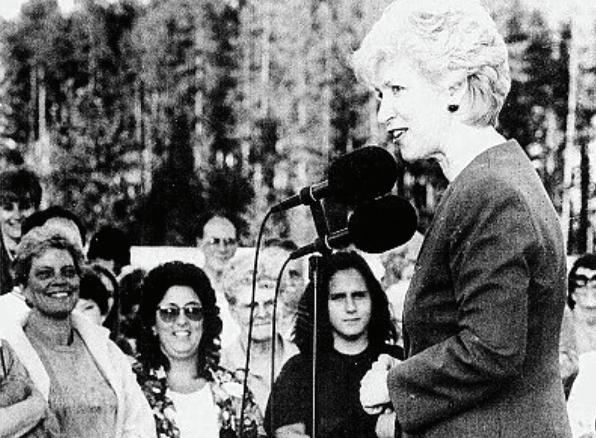


Aug. 7, 1985: Education Minister Jack Heinrich got a taste of what school was like in South Fort George in 1910 when he took part in the dedication ceremony for the village’s original schoolhouse, which had been xed up and moved from its Queensway location to the Fort George Regional Museum (now The Exploration Place). CITIZEN FILE

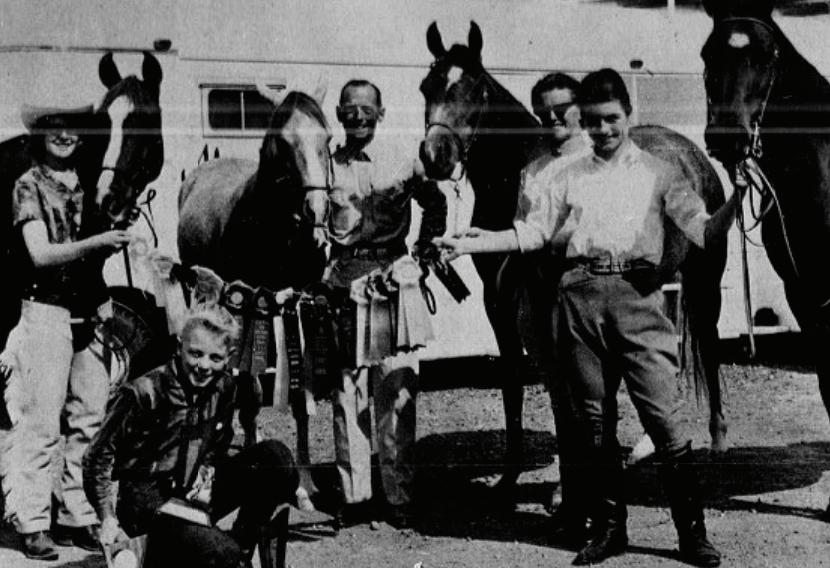
Aug. 10, 1964: Four show horses from Prince George returned from a tour of southern Alberta and the Okanagan, where they collected 16 ribbons. The group included, from left, Patricia Roine with lly Nichako Mist, Charlie Shields with Meadowlark Arabians’ yearling lly Tsana of Al-Marah, Betty Shields with Kiswa and Catherine Shields with her jumper, Little Dark Teoga. In the foreground is Ricky Fifer of Vernon. CITIZEN FILE








Dr. Anna Kindy says the system is broken, and patients are suffering the consequences
TED CLARKE Citizen Staff
As a family physician in Campbell River, Dr. Anna Kindy knows that when someone suffers life-threatening injuries or becomes critically ill, time is crucial. The longer it takes to receive emergency medical care, the worse the outcome.
Time is a killer — it increases the morbidity of injuries and raises the risk of death.
Countering that, Kindy says, requires a nimble, well-equipped ambulance system capable of bringing the hospital to the patient — wherever they are — on what may be the worst day of their lives.
But according to Kindy, British Columbians, especially those in rural areas, are too often let down by gaps in the province’s emergency medical response system.
Kindy, the BC opposition health critic and MLA for North Island, says the ambulance system is inefficient and lacks the resources to provide adequate coverage across the province.
“Too many doctors and nurses whose patients need to be moved immediately to a higher level of care are frustrated waiting for an air ambulance that arrives too late,” she said. “Too many paramedics are seeing worst-case patient scenarios that traumatize them and lead to stress leave. Too many patients are losing limbs or suffering long-term brain damage after strokes because they didn’t receive timely treatment.”
Kindy doesn’t expect a smaller city like Campbell River to offer specialties such as cardiac surgery. But she says that where those services are lacking, the province must ensure better patient transport.

“Knowing we don’t have that service, we should have the best transport possible, and that’s what we’re not getting,” she said.
The Fraser Institute projects BC will spend $39 billion on health care this year, including a $1.7-billion boost from the Eby government, a 4.6 per cent increase in the health budget.
“Health-care reform is clearly on the mind of most Canadians and was a core issue in the recent BC election,” the institute stated. “Unfortunately, with its latest budget, the Eby government has decided to follow a staple of ‘health-care reform’ in Canada — namely, to spend more but make almost no fundamental changes.”
Kindy is calling for radical reforms to bring the province’s ambulance system
in line with other Canadian jurisdictions and many Western European countries. She wants BC to scrap what she describes as a provider-centric, paramedic-only model and shift to a patient-focused approach that uses multi-disciplinary teams.
She believes a properly functioning, patient-first ambulance system would ultimately save the province money, as faster treatment would shorten hospital stays and lead to better recoveries.
“If we have a pre-hospital system that works well and treats patients on site or during transport, it prevents disabilities or severe injuries and saves lives,” said Kindy. “People with disabilities tend to cost more in the long term. Up-front costs will save you money down the line.”
In January, an infant awaiting air transport in Cranbrook died before a BC Emergency Health Services (BCEHS) medevac team could arrive. The team had been expected within two hours.
Staff at East Kootenay Regional Hospital requested a STARS helicopter from Calgary as a backup but were told the BCEHS infant transport team was en route.
“That should not be happening,” said Kindy. “If it’s patient-centred care, let’s get that person to the highest level of care as soon as possible.
“If you look at a typical city in Europe, it has more [medevac] helicopters than all of British Columbia. We’re under-resourced.”
Currently, BCEHS operates six air ambulance helicopters: two in Vancouver and one each in Parksville, Kamloops, Prince Rupert and Prince George. It also has nine fixed-wing aircraft: three in Vancouver, two in Kelowna, two in Prince George and two in Fort St. John.
Medical crews consist of advanced and critical care paramedics, not nurses or doctors. Availability, along with weather conditions, limits when and how often they can fly.
“Care levels are centralized and access to tertiary-level care is normal, but we should be able to access them more quickly with a Code Red urgent patient,” said Kindy.
“We’ve got dedicated teams here, but they’re under-resourced and under-staffed. If there’s a call-out, they’re delayed because of staffing issues. When you have a Code Red that becomes inaccessible for air transport, that’s traumatic for the doctor waiting, dealing with a very sick patient — sometimes a pediatric one.”
To better understand how multi-disciplinary medical transport teams work, Kindy visited the STARS (Shock Trauma Air Rescue Service) base in Calgary earlier this month. The not-for-profit helicopter-based system has operated since 1985 and now serves Alberta, Saskatchewan and Manitoba from six bases.
“It’s a very impressive setup — very professional,” said Kindy. “They have a lot of pride in their operation, and communities that access the STARS program seem pleased with it. I think we have to look at that kind of model for BC.”
She says the Alberta system is focused on patient outcomes, with decisions and quality measures based on patient needs.
“They’ll do everything to make sure the outcome for the patient is as good as possible, meaning rapid transport with appropriate staffing,” said Kindy.
STARS operates three bases in Alberta, two in Saskatchewan and one in Manitoba. It is funded through a
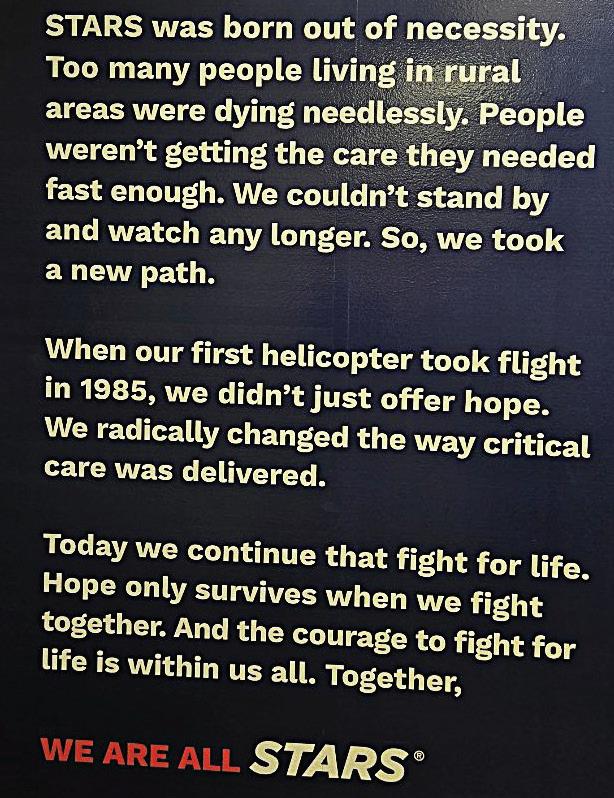
combination of provincial government support and private or corporate donations.
“When I was there, they had four crew members in every helicopter, with a backup team,” Kindy said.
“That includes two pilots, one or two advanced-trained paramedics with critical care capacity, and an ICU nurse trained in pediatric advanced care. They’re ready.”
STARS also allows doctors trained in emergency, critical care or anaesthesia to board flights as needed. Air medical
the opportunity to work alongside doctors and nurses.
“Training a paramedic at a higher level and having enough bodies when you transport — sometimes with backup from an ICU nurse, respiratory tech or doctor — brings more job satisfaction for everyone,” she said. “If a patient has a better outcome, everybody’s happy.”
Kindy says discontent with the current ambulance model is growing among medical professionals, including former BCEHS staff who resigned in frustration over the agency’s resistance to reform.
“We’re lucky to have people who are knowledgeable about medical transport and who are advocating for a better system,” she said. “We need to access their knowledge and look at where our system is failing. Why aren’t we putting patients first? It’s time to review our transport services and make them patient-centred.”
She also criticized what she called a culture of censorship in BC health care, where workers are discouraged from speaking out.
“Throughout health care, there’s a real censorship issue,” said Kindy. “People who want to advocate — nurses or doctors — are either not listened to or even reprimanded. I’ve heard that throughout the province. People tell me things in private but don’t want their names attached.
“We’re at a stage where, if a physician, nurse or paramedic wants to speak out, they usually aren’t allowed. That creates burnout and then they quit.
crews are on standby next to the helicopters 24/7, ready to launch a mission within 10 minutes of a 911 call—weather permitting.
STARS has an agreement to serve parts of eastern BC from bases in Grande Prairie, Edmonton and Calgary. Kindy acknowledges there would likely be pushback from union leadership — specifically the Ambulance Paramedics of BC CUPE Local 873 — if the province allowed hospital staff to join air crews. But she believes many individual paramedics would welcome
“There have been repercussions for advocating better care, and that should never happen. If you silence the front lines, you don’t get the information you need to change the system.”
She cited the closure of tertiary pediatric care in Kelowna as an example of systemic failure.
“This was years in the making, and they had years to find a solution. The front lines offered one, but they weren’t listened to,” she said. “We’re in a healthcare crisis, and the only way to solve it is to work together.”
The service is always looking to improve, spokesperson says in a prepared statement
TED CLARKE Citizen Staff
In the face of mounting pressure on the ambulance system — driven largely by the opioid overdose crisis and a lack of resources — BC Emergency Health Services says it is continually looking at ways to innovate its emergency care procedures and ambulance transport systems.
In an email to The Citizen, BCEHS chief operations officer Jennie Helmer responded to criticism from Abbotsford Regional Hospital intensive care physicians Michael Christian and Neil McLean — both former BCEHS medical executives — who say the organization is unwilling to fundamentally change its operational procedures and stubbornly refuses to listen to suggestions from staff to adopt methods of patient care proven more effective in other jurisdictions.
“A learning organization, we are always looking at effective and innovative ways to enhance our service and get the best help to people as fast as possible when they need us most,” wrote Helmer.
“We are always open to quality insights from qualified experts and implement innovations which improve care and save lives.
“Like many parts of the health system, BCEHS operates under significant and increasing pressure. Paramedics provide advanced emergency medical care in the field, stabilizing patients and ensuring safe transport. Their clinical expertise is critical — and it allows physicians and nurses in emergency departments to focus on delivering the next level of care.”
To boost paramedic coverage to staff air ambulance flights, Helmer wrote, BCEHS has created two new paramedic

A patient is wheeled from a BCEHS helicopter on the rooftop helipad into Royal Columbian Hospital in New Westminster.
classifications, one of which will provide the opportunity for primary care paramedics to join flight crews to respond to lower-acuity patient transportation needs.
The primary care flight paramedic and advanced care flight paramedic roles will increase overall staffing for the seven helicopters and 12 fixed-wing aircraft that make up the BCEHS fleet — to decrease response times and enable critical care paramedics to focus more on the sickest or most severely injured patients.
The first 37 graduates of the flight training and education program will be filling those roles by the fall of 2025, and 12 of them will be based in Prince George.
In 2024, BCEHS responded to a
record 607,716 calls for ambulances, of which two-thirds were high-acuity (life-threatening) cases — largely driven by the opioid overdose crisis — while the other third were low-acuity calls.
To try to reduce pressure on the ambulance system and help people get emergency medical care sooner, the provincial organization has launched its Clinical Hub, which connects lower-acuity patients to the right level of care — freeing up ambulances and paramedics to respond quicker to patients with more urgent health concerns.
The Hub is able to assess patient needs and provides conveyance and care alternatives for people who might
not require emergency transport to a hospital.
“It’s important to recognize that ambulances are not a substitute for hospital care, but rather a key link in a coordinated system,” wrote Helmer. “Patients transported by BCEHS are already in the hands of skilled emergency medical professionals, specifically trained for pre-hospital care — ensuring continuity and safety throughout their journey.”
BCEHS, armed with a staff of 6,000 paramedics, dispatchers, emergency medical call takers and support staff, continues to struggle with trying to reduce wait times and meet response time targets.
Cor van der Meulen (centre), with his wife Judy, three sons, and their families, celebrated his retirement from Northern Health in April 2024 after an extraordinary 51-year career in medical imaging (50 of those years spent with NH). Born in the Netherlands and raised in Smithers, van der Meulen began his career as a medical radiation technologist (MRT) in Kamloops in 1973 and was there one year before returning to Smithers, where he worked for 50 years.

On July 28, Helmer addressed Delta city council in response to a Vancouver Sun article in May, which showed ambulance response times in Delta were the worst in Metro Vancouver — averaging 15 minutes and 46 seconds — well above the nine-minute target.
As documented in Thursday’s Citizen article, wait times for rural BC residents are much higher — more than 11 hours for 90 per cent of calls — and nearly 17 hours for most BC First Nation patients.
“We need more resources, we need to be able to manage our patients differently than we did in the past, and we need our patients to understand that as well — that a call to 911 could mean many things. It doesn’t necessarily mean a trip to the hospital anymore, and we’re working really hard at those alternative options as well,” said Helmer.
Helmer pointed to the province’s
Collaborative Heart Attack Management Program (CHAMP), which allows advanced care paramedics — in consultation with an emergency room physician — to administer clot-busting thrombolytic therapy while on the way to the hospital for patients suffering a severe heart attack.
More than 100 patients have received that treatment in an ambulance since the program began.
BCEHS has also created the Community Paramedicine program geared to rural and remote areas of the province to provide healthcare home visits to people with chronic conditions and preventative community outreach and education to help prevent unneeded 911 calls.
Paramedics also have access to the Emergency Physician On-call System (EPOS), which provides a live link to a physician for patient-side consultation.
“Fully dedicated, these 6,000 emergency medical professionals deliver the
best possible patient care over 600,000 times a year, across a geographic area the size of France and Germany combined,” wrote Helmer. “We live in these communities. Our patients are our community members, friends and neighbours. Delivering the best possible patient care is the heart of the work we do.”
In a Citizen story published Thursday, July 31, Christian and McLean said the BCEHS system is healthcare-provider centric, not patient-centric, and what’s best for paramedics overrides what’s best for the patient.
They also said the province’s patient transfer system is inadequate and that rural BC patients suffer the most — with long wait times and lack of aircraft availability for retrievals and repatriation — resulting in bed blocking at tertiary hospitals after they’ve received treatment.
They say the paramedic shortage and lack of flights to deliver a patient to a higher level of care results in doctors
and nurses being forced to accompany patients for long highway trips in the back of an ambulance, and the lack of hospital staff sometimes forces smaller hospitals to temporarily close their emergency rooms.
Christian and McLean have suggested allowing hospital staff on BCEHS air ambulances will alleviate some of the strain on the patient transfer network. They are also convinced having a system capable of sending advanced care quickly to stabilize a patient before transfer will reduce healthcare costs and help patients recover more quickly — and that with doctor or nurse support, BCEHS paramedics would be less likely to suffer stress-related disabilities that result from being forced to deal with the most urgent cases and go beyond their usual medical scope of practice.
None of the questions based on the two doctors’ comments were answered, and The Citizen’s request to speak to Helmer in an interview was denied.
SANJA KNEZEVIC Northern Health
Northern Health (NH) continues to celebrate the staff and medical professionals who exemplify its core values — empathy, respect, collaboration and innovation — through the annual Dr. Charles Jago Awards.
Named after NH’s former board chair, the awards recognize outstanding contributions that advance the organization’s goals while demonstrating these foundational principles.
Heather Ouellette:
2025 recipient for respect
The 2025 Jago Award in the respect category goes to Heather Ouellette, team lead of specialized services. Known for her unwavering compassion and dedication to both her clients and colleagues, Ouellette fosters an inclusive and supportive team culture where every individual feels heard and valued.
“Heather exemplifies respect in everything she does, both as a leader and a colleague,” shared her team. “She consistently shows genuine care for everyone she works with, taking the time to remember each client’s name and the unique aspects of their needs.”
Her leadership style is characterized by an open-door policy, a calm and thoughtful approach to challenges, and a commitment to building trust within her team. She encourages growth by recognizing individual strengths, offering constructive guidance and celebrating achievements.
Originally from the Peace country of Alberta, Ouellette moved to Prince George in 2005 from Edmonton to be with the love of her life. She has held various roles within Northern Health, including in nursing support services, public health and pediatrics.
After a five-year stint teaching at the University of Northern British Columbia (UNBC), she returned to NH and took on the role of team lead during the integration of public health into primary care.
Ouellette speaks fondly of life in northern BC: “There is just so much to



see and do and enjoy in the North,” she said. “The people here have that can-do attitude that looks for solutions, never hesitating to be creative.”
Outside of work, she embraces the outdoors through hiking, mountain biking, canoeing and gardening. She also enjoys sewing, quilting and knitting, and often hosts gatherings on her acreage deck, where she brings people together in a warm, relaxed setting.
Darren Ditto: 2
025 recipient for innovation
This year’s innovation category award goes to Darren Ditto, director of clinical information systems operations.
Ditto is celebrated for his practical and forward-thinking approach to system solutions in a resource-limited environment.
Having joined Northern Health in 2011 as regional manager of corporate application services, he later transitioned to primary and community care, where he has spent nearly 15 years improving health-care delivery through innovative IT strategies. He is particularly adept at working alongside clinical teams to identify and implement improvements that enhance efficiency and patient care.
“Darren doesn’t see problems — he sees opportunities,” said Vanessa
Kinch, the 2024 Jago Award recipient for respect. “His solutions are not only creative but also deeply practical, always mindful of sustainability and fiscal responsibility.”
His leadership fosters a culture of curiosity and shared innovation. Ditto encourages open collaboration and empowers his team to think creatively while focusing on outcomes that support NH’s broader goals.
Away from work, he enjoys cross-country skiing, coaching and software development. Like many of his Northern Health colleagues, he values the vast outdoor experiences offered by the region — from serene lakes to rugged mountain terrain perfect for skiing, biking and hiking.
Beth Ann Derksen: 2025 recipient for collaboration
The collaboration category honours Beth Ann Derksen, executive lead for critical care, whose career with Northern Health spans decades and includes diverse roles across multiple communities.
Derksen began her career in 1976 as a general duty nurse in Fort St. James, long before NH was formally established. She has since held numerous positions, including supervisor, emergency nurse, psychiatry nurse and
director of mental health and substance use for the northwest region. Her recent role as executive lead for critical care brought her career full circle, culminating in her retirement on June 26, 2025.
Her colleagues describe her as someone who fosters connection and encourages networking across teams and regions. Christine Gaudreau, program service specialist, shared how Derksen supported her involvement in a cross-functional quality improvement project despite her primary focus being acute care.
“Beth Ann encouraged collaboration not only within NH but also across the province,” added Joan Cuevas, program/service specialist. “She supported me in bringing my strengths to provincial working groups and always respected individual working styles. That respect boosted our commitment to team goals.”
Derksen’s long-standing dedication to the North is matched by her deep appreciation for its communities and people.
As she moves into retirement, she plans to enjoy gardening, spending time with family and friends, cooking, reading and volunteering.
She also has a creative side, delighting in sewing costumes for theatre productions.
Josie Osborne tours Williams Lake health facilities as part of a trip into the Interior
ANDIE MOLLINS Local Journalism Initiative Reporter
Williams Lake Mayor Surinderpal Rathor made several requests to B.C. Health Minister Josie Osborne during her July 22 tour of the Interior region.
“I am very happy and delighted with the meeting I had with the minister,” Rathor told The Tribune. “I will be more delighted when she delivers.”
And deliver she will, Rathor said with confidence.
“There’s no reason not to believe her ... almost everything I have asked Victoria for, they have delivered,” he said. Rathor handed a list of priorities to Osborne, which they discussed during the meeting.
He said she promised to work on them.
“My most important point is the mental health,” he said, adding the city has issues with drug use and needs greater access to wraparound services.
“I want them to go to the proper treatment,” said Rathor. “I feel sorry for those people; they’re not there by choice, they’re there because they had no choice ... I have an equal heart for everybody, and that’s my duty, my job, my responsibility.”
Rathor said he wants to see more detox beds in or near Williams Lake. He also said a broader strategy is needed to ensure overall safety in the community.
“We need those things ... and I requested her to address that ASAP.”
The mayor said he also emphasized the city’s need for more health-care workers, especially as the multi-million-dollar addition to Cariboo Memorial Hospital nears completion.
“There are lots of people sniffing already,” Rathor said Osborne told him. He said she mentioned many are looking forward to working in a new, upgraded hospital rather than older

facilities elsewhere.
Among those interested, he said, are “our very own” UBC students nearing graduation, who won’t need further licensing and will be able to start work immediately.
The pair discussed a range of possible solutions, including expediting credential transfers for out-of-province healthcare workers, introducing recruitment incentives for rural BC, offering financial support, and implementing policies to create more training opportunities.
“We are trying our best to do whatever we can,” Rathor said of the city’s efforts to address these challenges.
“Have we resolved the homelessness?
of the realities each community faces. Along with the mayor, Osborne met with Kukpi7 Willie Sellars and local health-care practitioners, and she toured the new Urgent Primary Care Centre and the All Nations Healing House.
“It’s incredibly inspiring,” she said of how the All Nations Healing House combines traditional and modern medicine to provide culturally safe, trauma-informed care.
On Wednesday, Osborne visited the Cariboo Memorial Complex and toured the new hospital tower under construction, which she said is looking “phenomenal.”
“It’s just really good to see that that’s the kind of state-of-the-art facility we can build ... people in rural communities really deserve it,” she said.
Osborne also discussed how the delivery of medicine is changing, and how team-based care models, like those used at the All Nations Healing House, can be implemented more widely.
As part of the ministry’s strategy to address the health-care worker shortage, Osborne said a new medical school will open in Surrey next year with a focus on family medicine.
“Ninety per cent of students who do medical school in B.C. stay in B.C.,” she said, adding she is optimistic this will help retain more workers in the province.
No. Have we resolved the mental health? No. (But) we have done lots,” he said. “We have come a long way, but my famous saying is, ‘We have a long way to go yet.’”
What’s important, he said, is that the city is making progress — and he believes it is.
“In the past we have resolved so many issues. We will resolve this issue also.”
In an interview with The Tribune, Osborne said she enjoyed visiting Williams Lake.
“It’s so important for me to get out and away from Victoria and talk to people in our communities,” she said, adding it gives her a better understanding
Osborne said she had a productive meeting with the mayor and shared updates on the ministry’s efforts to build a continuum of care for mental health and substance use.
“It’s important to hear about the challenges right from the ground, but also to discuss opportunities,” she said.
Both Osborne and Rathor said they look forward to continuing their work together.
“Working together is the best way to do it,” Rathor said.
Osborne’s tour of the region began and ended in Kamloops, with stops in Vernon, Cache Creek and 100 Mile House along the way.
This story originally appeared in The Williams Lake Tribune


TED CLARKE Citizen Staff
Nevada Jones had a lot to juggle with at the 77th annual National High School Finals Rodeo in Rock Springs, Wy.
As if it wasn’t stressful enough to be the Miss BC High School Rodeo Queen, representing all of British Columbia among 42 other contestants from Canada, the United States and Mexico vying for the national crown, the 17-year-old from Prince George also had to take care of business competing in two of her bread-and-butter rodeo events.
Jones qualified for the Super Bowl of high school rodeo in breakaway roping and pole bending and with that came the added responsibility of getting three horses — Cello, Owen and Gordon — ready to ride.
“It made for a little bit more chaotic of a week with so much on my plate but it was still a great experience,” said Jones, who won a saddle as BC reserve champion in breakaway and was sixth in the province in pole bending. Judging to determine a rodeo queen is based on several elements, including horsemanship and the ability to follow commands riding a pattern in the arena that includes circles, stops, backups and rollbacks.
Each contestant is required to give a two-minute speech and points are awarded based on how they present that speech. Modelling is another of the requirements and contestants are judged on the confidence and grace they show as well as audience engagement. They also earn points based on how they respond to an impromptu question and for their overall appearance.
Jones was one of four competing for the Miss Rodeo title at the BC High School Rodeo Finals in Quesnel and winning it was an unexpected bonus for Jones, who comes from a three-generation family of rodeo contestants.

“It was completely new to me in this last year,” she said. “It was something my sister tried and I always had an interest in it but didn’t know how far it would take me.
“I think the toughest part was just balancing the switch between having to do my queen stuff and being a competitor — definitely some long days and late nights because there’s so much to fit in.”
The national finals drew more than 1,700 competitors and crowds of between 6,000-12,000 people for each
go-round.
She had a chance to get to know some of the other rodeo queen contestants at planned events throughout the week (July 13-19) and got her first taste of celebrity status.
“It’s so amazing to meet so many people and we all have a love for rodeo. We were competing against each other but we were also friendly as well,” said Jones.
“We had some meet-and-greets with fans and during the rodeo we had autograph signings. That was different,
I’d never signed an autograph sheet and it was cool to have that experience. All the little kids that came up looked up to us.”
Breakaway is a timed event in which riders chase after a calf released from the chute and rope it around the neck. The other end of the rope is tied with a string to the saddle horn and as it tightens with the running calf the string breaks and that stops the clock.
”Breakaway is definitely my favourite event, I have a great team of horses for it and it’s something I grew up doing,” said Jones. “Cello is my main horse, he’s just super-reliable and great for the setups we have in BC. We’re in a lot of indoor (arenas) so he’s really good for scoring there big, outdoors he likes to run hard and out me in my spot every time.
“Owen is my backup horse. He’s a little more of a stronger runner so when I draw a calf that likes to run fast I go on him, and my sister’s breakaway horse, Gordon, is the one I used at nationals.”
Breakaway’s exposure grew by leaps and bounds when a national TV audience tuned into the 10-day Calgary Stampede in the early July. This year it became one of the major rodeo events at the Stampede and the inaugural champion who won a $50,000 prize is Calgary native Shelby Boisjoli-Meged.
“Unfortunately I couldn’t watch the Calgary Stampede on my phone, I just watched little snippets of it on Instagram or Facebook and it was so cool to see a Canadian cowgirl, especially one in her hometown rodeo, being such a big rodeo, win that first-ever Calgary Stampede in breakaway roping.
“A lot of people do that for a living and that’s their main passion. It’s really amazing, especially as a young breakaway roper to know that it’s evolving so much and there’s so much out there for me in the future.”

There will be as many as 6,000 athletes and supporters in the city Aug. 11-17
MATTHEW HILLIER Citizen Staff
The upcoming 67th annual provincial swimming championships, hosted by the BC Summer Swimming Association (BCSSA), has put staff at the Prince George Aquatic Centre into high gear.
Staff are preparing to welcome approximately 6,000 athletes, coaches and family members for a massive competition.
The championships are set to take place between Aug. 11 and 17 and will feature diving, artistic swimming, water polo and speed swimming.
“This is an exciting time for the aquatics team at the City of Prince George,” said aquatics division manager Jim Worthington.
“We are thrilled to be hosting provincials at the Aquatic Centre for the second time since 2007. We wish our local clubs the best of luck and look forward to welcoming the rest of the province to Prince George this month!”
To prepare for the provincial competition, the Aquatic Centre will experience some partial closures beginning next week:
• Fitness centre closed from Friday, Aug. 8 to Monday, Aug. 18 (remaining facilities open)
• Wave pool closed from Saturday, Aug. 9 to Friday, Aug. 22 (remaining facilities open)
• Full Aquatic Centre closure to the public for provincials — access only to those registered — from Monday, Aug. 11 to Sunday, Aug. 17
The Canfor Leisure Pool will remain open with regular hours of operation during this time.
For more information about pool hours and rates, visit: https://www. princegeorge.ca/parks-recreation/ aquatics
The BC Summer Swimming Association (BCSSA) is organized into eight geographic regions within BC: Cariboo, Fraser South, Fraser Valley, Kootenay, Okanagan, Simon Fraser, Vancouver and Districts and Vancouver Island.
For information about the swimming championships, visit the BCSSA website: https://www.bcsummerswimming. com/provincials
Jones has been roping almost since she started walking, practicing her swings on dummy calves for Little Britches rodeos.
Her mom, Christine, her dad, Darin, and sister Fallon all compete in roping events. Fallon, 20, is in her third year attending Idaho State University on a rodeo scholarship. Her aunt Sandra Suter is a former Canadian champion and multiple World Series team roper and her grandfather Garry Suter established a long history as one of the province’s top team ropers.
Jones has been invited to compete in three events (breakaway, pole bending
and team roping) at the Canadian Youth Rodeo, Championship, Oct. 2-5 in Edmonton. She’ll team up with Kenzie Lloyd of Quesnel for the team roping competition.
Jones missed her hometown rodeo in mid-June while competing in the provincial high school finals in Quesnel but will get to compete in the BC breakaway championships during the BC Northern Exhibition, Aug. 16-17.
She’s spoken to a few college recruiters and next year plans to attend a U.S. junior college to study health sciences and biology, working towards a medical radiography technology degree after she graduates from Prince George Secondary School.

Seventeen-year-old Nevada Jones of
ing at the
Gavin Halvorson was born three months after his father, Jeff, died on the Okanagan Suns’ practice eld
TED CLARKE Citizen Staff
Gavin Halvorson had the kind of breakout game he’s been looking for ever since he came to Prince George a year ago to resume his junior football career as a running back with the Kodiaks.
He rushed for 110 yards and scored two touchdowns to lead the Kodiaks to their first win of the season last weekend (July 26) in Kamloops, a 33-13 triumph over the Broncos.
And he did it wearing No. 34 on his jersey, the number his dad Jeff wore for two seasons in two spectacular seasons with the Okanagan Sun before his sudden death on the practice field in Kelowna.
Jeff died at age 21 on Sept. 1, 2004, three months before Gavin was born. An autopsy attributed his death to an airborne virus that affected his lymph nodes which led to heart failure.
The year he died, Jeff was leading the BCFC with 788 yards and 16 touchdowns through six games. Considered the fastest running back in the league, the Wembley. Alta., native scored 32 touchdowns in just 15 games over two seasons.
At the time of his death he was married to wife Leah and they had a young daughter, Cheyne, now 22.
“I just heard he was a good guy and a hard worker and he played really well,” said the 20-year-old Gavin. “He passed away before I was born and mom moved back to Sylvan (Lake) with my sister and moved in with my grandparents and went back to school (and studied to be a legal assistant) and I started playing football when I was seven.
“I’ve been around football my whole life, this is my 13th or 14th year. I’ve done a lot of training in the off-season

Jeff Halvorson, at left in this composite image, was an All-Canadian running back for starred for two seasons (2003, 2004) with the Okanagan Sun until he collapsed and died of a viral infection on the practice field in Kelowna, Sept. 1, 2004, three months before his son Gavin, right, was born. Gavin, 20, is in his second season with the Prince George Kodiaks and he had two touchdowns and 110 rushing yards in a 33-13 win July 26 over the Kamloops Broncos.
and I have had a lot of good coaches growing up.”
Gavin, a native of Sylvan Lake, Alta., started his BC Football Conference career playing for the Okanagan Sun in 2022 and was a defensive back during their run to the Canadian Bowl national championship. The Sun beat the Regina Thunder 21-19 in Regina to capture the crown.
Gavin scored the first touchdown of the game and first of his BCFC career last weekend in Kamloops, plunging into the end zone from one yard out. He also scored in the second half on a two-yard carry after punt returner Andrew Brown almost ran the ball back all the way.
“It was my first 100-yard game and first touchdown in the league,” said Gavin.
“That was a good one for him,” said Kodiaks head coach Jamie Boreham. “It was nice that the line was able to get things turning and Gavin was finding holes and hopefully he can continue running the ball effectively.”
Jeff grew up in Grande Prairie and started his BCFC career with the Edmonton Wildcats. The Edmonton
Eskimos and BC Lions wore JH helmet decals during a CFL game shortly after his death as a tribute to Jeff.
He was an exceptional athlete and Gavin uses that as his motivation to set the bar high and perform to the best of his abilities, whether it’s on the football field on a game day, running a practice drill or working out in the weight room. His legacy inspires Gavin to keep up that family tradition.
“It does, for sure, especially I’m getting a little older now and I’m in the years that he played, so it’s kind of now or never, I guess,” said Gavin.
“My family are happy I’m still playing and love coming out to games. I had a bunch of family come out to PG (for the season-opener against Westshore) and then my grandparents came to the Kamloops game with their siblings.”
Leah has since remarried and she and her husband Ryan Smith have a younger son, Ronin, 13, who lives with them in Sylvan Lake.
Gavin’s sister is a university student in Ohio. Leah tries to get to as many games as she can and she’s elated to see her older son making an impact as
one of the Kodiaks’ top performers.
“Gavin is a quiet leader on the field and that is how Jeff was described as well,” said Leah. “Gavin celebrates his teammates’ successes louder than his own and that is something Jeff was known for too. Neither were too flashy or were ones to seek out attention. I think Jeff would of course be proud of Gav and just enjoy seeing him working hard and having fun on the field.”
Jeff was a track and field sprinter who made the junior national team in his late teens and won a bronze medal in the 400m event at the national championships in Montreal. Gavin knows he has athletic genes racing through his blood.
“Gavin definitely got his speed from the Halvorson’s, but my family is pretty competitive and athletic as well,” said Leah. “We have volleyball and basketball players on my side...neither of which Gavin chose to play growing up, which is a difference from Jeff actually. Jeff played all the sports, while Gav stuck to the ones he loved, being football and lacrosse.”
After winning the national title with Sun in 2022, Gavin took a year off from junior football and instead chose to spend the summer at Sylvan Lake playing for men’s league team. Boreham was head coach of the Sun when he originally recruited Gavin to Kelowna and his persistent texts pleading for him to come to PG finally paid off.
“Gavin was one of my neater recruits, that’s for sure, when I recruited him to the Sun, so to have the opportunity to bring him here so he can find a fit and the opportunity he’s looking for — we’re super-excited about him, he’s put the work in in the off-season,” said Boreham.
“Gavin’s embraced his dad’s number as his number and that’s pretty special for a young guy. I hope he has a great game and gets all the things he deserves with his hard work. He runs hard and he understands the system. Every time he’s getting the ball ornhe’s blocking you know you’re getting Gavin’s best. He’s just an all-around good kid.”
Gavin says he’s had no problems adjusting to life in Prince George and said Kodiak fans make the games at Masich Place Stadium an unforgettable experience for the players. They felt that love from the fans on the road in Kamloops as well.
“The team feels a lot like family, a good group of guys and it’s a great community up here,” he said. “Everyone’s a lot louder here, I think that’s a North thing. When we played in Kamloops we damn near had as many fans as (the Broncos) did.”
Jeff was on his way to becoming a certified plumber when he died and Gavin says he’ll likely follow a similar career path to get some kind of trade under his belt.
In the meantime, Gavin has returned to his summer job working on the maintenance crew at Prince George Golf and Curling Club.
He likes golf but it’s more of a hobby that a passion. If he had to pick a sport
other than football to play it would definitely be lacrosse.
He played Canada’s national summer sport since he was a kid and was the Sylvan Lake Yetti junior B team for several seasons before he gave that up in 2022 when he went to Kelowna.
“I do miss it,” he said. “I was an offence guy but to be honest I was probably better in defence.”
Leah tries to get to as many games as she can and plans to be there.
“We are absolutely proud of Gavin and of all his hard work and effort for the game,” said Leah. “It is pretty special to see him wearing No. 34 for the first time, and it will be great to see him wearing it in the Apple Bowl on Saturday.”
Gavin was sidelined with a shoulder injury a year ago when the Kodiaks played the Sun in Kelowna and lost 70-0 — their worst defeat since Prince George joined the BCFC as an expansion team in 2022. He’s looking forward to giving the Sun a much tougher game on Saturday.
The Kodiaks’ defence was dominant in Kamloops, allowing just 102 yards of net offence. They held the Broncos to 18 yards in the entire second half – their best defensive performance in team history.
Punter/placekicker Brady Harper hit two of three field goal attempts and his booming punts forced the Broncos to concede three safety touches.
The Kodiaks are loaded with returning players with years of experience in the league and for the first time in their four-year BCFC existence they’re showing signs they’ll be a playoff team this season.
“Everyone here is older, in their fourth of fifth years and we have great coaching,” said Gavin.
“All the kids that came in this year are a great fit for the team and we like having them here and they’re playing well. Everything is just working together.”
Turn to Page 40 for coverage from Saturday’s game against the Okanagan Sun.


TED CLARKE Citizen Staff
The Prince George Kodiaks took on the defending BC Football Conference champions Saturday, Aug. 2 in Kelowna and didn’t win the game but accomplished something no other BCFC team has done so far this season.
They actually scored some points against the top-ranked Okanagan Sun. In fact, the Kodiaks put the first 11 points of the game on the Apple Bowl scoreboard, but ultimately lost 35-11. It started well for the Kodiaks. On the game’s opening series they held their ground on Okanagan’s thirddown gamble and forced the Sun
to turn over the ball. Prince George quarterback Sawyer Thiessen took over from his own 26-yard line and marched the team all the way to paydirt, connecting with Myron Brown on a seven-yard touchdown pass to open the scoring.
Brady Harper provided the convert and booted the ensuing kickoff into the end zone for an 8-0 lead, then provided a 36-yard field goal near the end of the first quarter to put Prince George ahead 11-0.
The Sun got its offence going in the second quarter with a Liam Attwood field goal and Glen Kodua ran back a punt 64 yards for a touchdown. A missed field goal and a punt that forced the Kodiaks to give up a safety
gave the Sun a 13-11 lead at halftime. The Kodiaks faced a stiff breeze in the third quarter and struggled to move the ball.
Marcus Cristos scored on a six-yard run and the Sun added another single point on the kickoff to increase their lead to 21-11.
In the fourth quarter, Cristos relieved quarterback Liam Kroger and put together a pair of touchdown drives, first hooking up with Tyler Craver for a 27-yard major. Gerren Hardisty also scored on a one-yard plunge and finished the game with 208 yards on 38 carries.
Thiessen went 12-for-16 with 128 yards through the air with one touchdown and one interception. He also
contributed 38 yards rushing on three carries,
Kodiaks running back Gavin Halvorson was held to 46 yards rushing on 14 attempts against his former team.
Caden Crow led the Prince George defence with eight tackles, while Carter Hall, Dillon Piddocke and Nick Tremblay each had four tackles.
The Kodiaks enter the bye week with a 1-2 record, having played to two toprated teams in the BCFC.
They started at home, losing 33-13 to the Westshore Rebels, ranked fifth in Canada, then went to Kamloops and beat the Broncos 33-13.
The Kodiaks will be back in action at Masich Place Stadium on Saturday, Aug. 16 to face the Langley Rams.
TED CLARKE Citizen Staff
Zane and Diane Pickering know they’ve got a good thing going with their experienced team of draft horses.
Those big guys are putting Prince George on the map, performing arena magic in some of the biggest horse shows in North America.
That started in early July when the Percheron stars of the ZD Pickering Family Farm flexed their muscles and dug in their hooves at the Calgary Stampede, winning the middleweight title at the world’s richest, most prestigious heavy horse pulling event.
After pulling in their prizes they packed up and went to Lloydminster, Alta., where they hitched up for the Lloydminster Exhibition and cleaned up, winning the ladies cart, men’s cart, youth cart classes, as well as the big-six hitch, four-up hitch and unicorn (one horse leading a team of two) wagon classes.
The Pickering clan also placed second in two senior team events and were awarded the Rusty Bexon Memorial Man and Horse Award.
The winning continued July 24-26 at

the Vermilion (Alta.) Agricultural Fair with the Pickering team capturing the big six hitch event, with Tim Sparrow of Indiana holding the reins, and they won the ladies cart class, driven by Brittney Sparrow of Cromwell, Ind. The Sparrow children, Rylen and Brynn, also drove carts and posted two-four placings in their respective junior and intermediate classes.
The Pickerings also placed second in the four-up class with Aaron Bonsburger of Indiana as the teamster. All of the Pickering Percherons are boarded with the Sparrow family in
Indiana. With the majority of horse shows each summer on the Canadian prairies or U.S. Midwest, the Percherons owned by ZD Pickering Family Farm in Prince George spend most of their downtime in Indiana, where Tim and Brittany Sparrow breed horses.
“We have nine horses, we bring younger horses that we’re training as well for exposure and we put them in the mix and keep rotating them in,” said Zane Pickering. “It we don’t feel a horse is up to snuff in a cart class then we’ll put another horse in, so we have options.”
Hitches in draft horse competitions are judged based on the physical conditioning of the horses, equine conformation, hoof size, cleanliness and overall appearance. Points are awarded based on the movement of the horses while following specific patterns in the arena and how they respond to the driver’s commands to initiate turns, stops and backward and forward movements. The appearance of the wagon/cart and how it performs is also evaluated.
“I always consider the cart class the most prestigious class of the show,” said Zane Pickering. “It’s the best horse of the bunch and it’s easy for the judge to single his concentration on one horse instead of six, so it’s tougher for him to make a mistake in that class than if he was judging six horses in a class.
“It gives the opportunity for the exhibitor to put their best horse, their best driver, their nicest cart up front to be judged, it’s a one-off thing.”
The Pickering horses got back to Indiana Thursday and they’ll have a week to get rested before their next event, the Indiana State Fair in Indianapolis. The Percheron/Clydesdale horse show starts Thursday, Aug. 7 and runs through Sunday, Aug. 10.






















Happy 90th Birthday, Cal Washington!
Dad, Grampa, Great Grampa - you are loved! Cheers to 90 years!




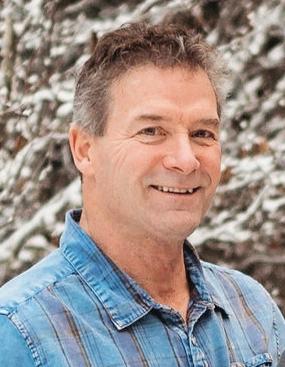
Lowell J. Dumonceaux
March 12, 1960 - April 5, 2025
Saturday August 16, 2025 at 11:00am
Hart Highlands Ski Hill (Upstairs Lodge) 3740 Winslow Drive, Prince George, BC

Marion Fuglem
December 6, 1933 - July 28, 2025
It is with deep sadness that we announce the passing of Marion Fuglem at age 91 due to cancer.
She leaves behind a loving family of 4 daughters, son in laws, grand and great grandchildren.
A celebraton of life will be held for her at Blackburn Community Hall, August 14th, at 1:00pm.
n leu of fowers the family asks that donatons be sent in her memory to Rotary Hospice House.


George F. Haley


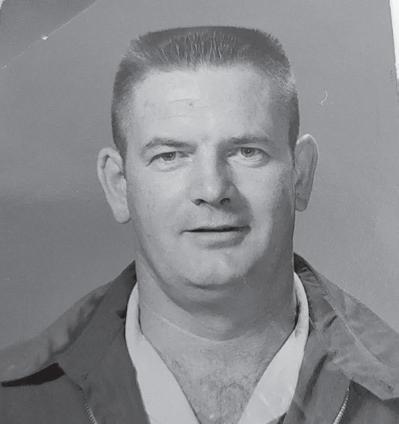
Lloyd and
Friday August 15th from 6-10 pm a WAKE for Earl will be held at the family home on Underhill Rd. P.G.
Open bar and snacks provided. Please arrange your own rides.
February 16, 1943 - July 24, 2025
It is with great love and heavy hearts that we announce the passing of our remarkable husband, father and grandfather George Haley.
Most people knew him as a family doctor, fur trapper, blacksmith, woodworker, fy fsherman and quintessental outdoorsman--- a true Renaissance man. But the role he held most dear was as a loving family man.
George was born in Santa Monica to Grace and Edgar Haley. He grew up mining tourmalines, huntng ratlesnakes and exploring the deserts of Southern California in his Willys Jeep. He atended McGill for his Master’s in Zoology and Dalhousie for medical school. Afer a brief return to California to marry the love of his life, they moved up to Northern BC in 1975, pursuing a lifelong dream of living among the forests, rivers and mountains.
George had many loves: his dogs, the northern lights, wolf howls, loon calls, the smell of autumn on his trapline, drifing on the Babine with his cane fyrod, the smell and smoothness of freshly sanded wood, his monthly fy-in clinics in Kwadacha and Tsay Keh, teaching medical students, laughing at a good joke, but most of all he loved his family: his beloved wife Liz; daughters Susie Butow (Bjorn), Kate Naphtali (Corey); and son Edgar Haley; and grandchildren Izzie, Ollie, Lily, Owen and Brooke. George is also mourned by his sister, Beth Flynn and family, and his brother Donald (Tami). We all deeply miss him.
A memorial gathering will be held at a later date.
Saturday, August 16th at 1:00 pm, P.G. Cemetary for Earl s interment. Afer the interment, the family welcomes friends and neighbours from 2-6 pm to the family home on Underhill Rd. Together we can share memories and the company of each other.
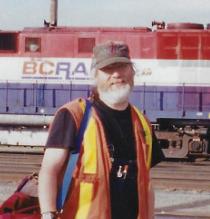
Fredrick Joseph Colliss
September 4, 1952 - June 11, 2025
Frederick Joseph Colliss passed away peacefully on June 11, 2025, afer a short but courageous batle with cancer.

He is sur i ed by daughter la, stepdaughter Michelle (Barclay) and stepson Bill (Tarra); grandchildren Nickolas (Hael), Jared, Liam Drebin. He is also sur i ed by his siblings, nieces, nephews, cousins and friends and his furry friend Groot.
A celebraton of life will be held on August 11, 2025, at the Courtyard Marriot rince George at 11 00am.
n lieu of fowers, donatons to the rince George Hospice alliat e Care Society or the Canadian Cancer Society would be greatly appreciated.

Add Colour for FREE to your la e a to stand out o e c ow





Fort George townsite was built 3.2 km (2 mi) to the northwest on the Nechako River. The name had been registered by the district lot original purchasers with some concerns due to its similarity to the HBC trading post’s name. George Hammond, the CEO of the Natural Resources Security Company, bought nine district lots and promoted his community of Fort George in exaggerated and questionable advertisements all over Canada and Britain, describing Fort George in glowing terms as being the future hub of British Columbia, the “Chicago of the north”, and having mild winters and being suitable for any agricultural endeavour. Hammond claimed the existence of buildings and facilities in advertising when none existed at the time. Lots sold in 1912 for $400, rising to $500-$1,000 by 1913.
Ten paddle steamer sternwheelers serviced the area, coming up on the Fraser River from Soda Creek[ docking at both South Fort George and Fort George Townsite.

* On Aug. 18, 1992, Boston Celtics forward Larry Bird retired at the age of 35, explaining that “the last couple of years have been very tough on me, on my back and on my body. It was very hard to deal with, day in and day out.” He has remained involved with the NBA in other roles, however, to the present day.
• On Nov. 11, 1831, Nat Turner, an American slave and educated minister who believed that he’d been chosen by God to lead his people into freedom, was hanged in Jerusalem, Virginia, for leading a revolt with 75 followers through Southampton County, killing about 60 white people.
• On Nov. 12, 1969, investigative journalist Seymour Hersh revealed the extent of the U.S. Army’s charges against 1st Lt. William L. Calley at My Lai, Vietnam, in a cable picked up by more than 30 newspapers, saying that “The Army says he [Calley] deliberately murdered at least 109 Vietnamese civilians during a searchand-destroy mission in March 1968, in a Viet Cong stronghold known as ‘Pinkville.’”
ARIES (March 21 to April 19) A more harmonious aspect favors all relatonships. Family tes with mates and children are strengthened. LIBRA is Cupid’s choice to win the amorous Arian’s heart.
TAURUS (April 20 to May 20) The bold Bull is ready to take on fresh challenges. Expect some oppositon as you plough up new ground, but supporters will outnumber detractors.
GEMINI (May 21 to June 20) An upcoming job change could mean uprootng your family to a far-distant locaton. Weigh all consideratons carefully before making a decision one way or the other.
• On Nov. 13, 1979, Philadelphia 76ers center Darryl Dawkins leaped over Kansas City Kings forward Bill Robinzine for a memorable slam dunk that shattered the fiberglass backboard. His equally memorable comment on the move, which was not his last and the sound of which spectators likened to a bomb going off: “It wasn’t really a safe thing to do, but it was a Darryl Dawkins thing to do.”
• On Nov. 14, 1882, outlaw Frank “Buckskin” Leslie shot and killed Billy “The Kid” Claiborne, who had publicly challenged him, in Tombstone, Arizona.
• On Nov. 15, 1984, Baby Fae, a month old infant who received the world’s first baboon heart transplant, died at California’s Loma Linda University 20 days after the operation. Three other people had received animal heart transplants, but none survived longer than a few days.
• On Nov. 16, 2001, British author J.K. Rowling’s most famous and beloved creation, the bespectacled boy wizard Harry Potter (played by Daniel Radcliffe in his first major role), made his silver-screen debut in “Harry Potter and the Sorcerer’s Stone,” which went on to become one of the highestgrossing movies in history.
• On Nov. 17, 1903, the Russian Social Democratic Labour Party split into two factions: the majority Bolsheviks and minority Mensheviks. The
* On Aug. 19, 2011, the “West Memphis Three” -- Damien Echols, Jason Baldwin and Jessie Misskelley -- were released from prison after serving 18 years for the murders of three young Arkansas boys, under the rarely used Alford plea, which allowed them to maintain their innocence while acknowledging that prosecutors still possessed sufficient evidence to convict them.
* On Aug. 20, 2000, the peregrine falcon, known as the world’s fastest bird for its speed of up to 200 mph, was removed
from America’s endangered species list after a little more than three decades. A ban on the pesticide DDT was widely credited for the bird’s resurgence.
* On Aug. 21, 1920, Christopher Robin Milne was born to author A.A. Milne and his wife, Daphne. The boy would later be immortalized in his father’s books “Winnie-the-Pooh” and “The House at Pooh Corner.”
* On Aug. 22, 1962, French president Charles de Gaulle, along with his wife, survived one of several assassination attempts against him thanks to the

CANCER (June 21 to July 22) A longstanding problem is resolved by a mutually agreed upon compromise. You can now focus on getng the facts you’ll need for a decision that you’ll soon be asked to make.
LEO (July 23 to August 22) The Big Cat needs to be wary of what appears to be a golden investment opportunity. This “sure thing” could turn out to be nothing more than a sack of kity liter.
VIRGO (August 23 to September 22) You give of yourself generously to help others, but right now, you must allow people to help you. Confde your problems to family and trusted friends.
superior suspension system of the presidential automobile, known as “La Déesse” (The Goddess), which allowed de Gaulle’s chauffeur to accelerate out of a front-wheel skid to safety.
* On Aug. 23, 1945, U.S. Army Staff Sergeant Marcario Garcia was awarded the Medal of Honor by President Harry S. Truman, becoming the first Mexican national to receive it, for single-handedly clearing two German machine gun nests even after receiving multiple wounds.

LIBRA (September 23 to October 22) Relatonships beneft from a strong harmonious aspect. Things also go more smoothly at work. Someone you thought you’d never see again asks for a reconciliaton.
SCORPIO (October 23 to November 21) A minor distracton interferes with travel plans, but the delay is temporary. Meanwhile, expect to play peacemaker once again for feuding family members.
SAGITTARIUS (November 22 to December 21) Keep positve momentum going on the home front. Arrange your schedule to spend more tme with your family. You’ll soon have news about a certain job change.

CAPRICORN (December 22 to January 19) Control your possessive tendency that sometmes goads you into an unnecessary display of jealousy. You could be creatng problems where none currently exist.
AQUARIUS (January 20 to February 18) A new project holds some challenges that you hadn’t expected. But don’t be discouraged; you’ll fnd that you’re more prepared to deal with them than you realized.
PISCES (February 19 to March 20) Yours is the sign of the celestal chemist, so don’t be surprised if you experience a pleasant “chemistry” betwixt yourself and a new LEO in your life.


Raised garden beds are an excellent way to grow vegetables, herbs, and flowers, especially in areas with poor soil or limited space. One of the most affordable and sustainable ways to build them is by repurposing old wooden pallets. With some preparation and care, pallets can be turned into sturdy, rustic garden beds that reduce waste and support eco-friendly gardening.
Select Safe Pallets
Not all pallets are safe for garden use. Look for ones stamped with “HT,” which stands for heat-treated— these are not chemically treated and are safe for growing food. Avoid pallets marked “MB,” which indicates they were treated with methyl bromide, a toxic pesticide that can leach into soil.
When possible, source pallets from grocery stores, garden centers, or hardware suppliers. Avoid ones from


industrial or shipping yards, which may have been exposed to harmful substances.
Carefully Disassemble or Repurpose
Disassembling pallets can be tricky. Use a pry bar and hammer, or a pallet buster, to take them apart without splitting the wood. Remove any nails or screws, and wear gloves and eye protection for safety. If you prefer, you can keep the pallet whole and use it as a garden wall or frame—this approach can save time and reduce labor.
Measure and Build
Plan your garden bed dimensions based on available space. A common size is 4 feet by 8 feet and 12–18 inches high, allowing easy access from all sides. Use the straightest pallet boards for the longer sides and sturdier ones for the corners. Secure them with galvanized screws or bolts








for strength and weather resistance.
Smooth and Seal (Optional)
Pallet wood can be rough and splintery. Lightly sanding the boards improves safety, especially in familyfriendly gardens. If desired, seal the wood with a non-toxic wood preservative to extend its lifespan. However, many gardeners leave the wood untreated to avoid introducing chemicals into the soil.
Prepare and Fill
Line the bottom of your raised bed with cardboard or landscape fabric to suppress weeds. Fill it with a rich mix of compost, topsoil, and organic material. This promotes healthy plant growth and improves drainage.
Maintain Seasonally
Pallet wood will naturally weather over time. Inspect your beds each season for signs of wear, loose nails, or rot, and make simple repairs as needed.



Building raised beds from old pallets is a creative and cost-effective way to garden sustainably. With a little time and effort, you can turn discarded wood into productive garden spaces that are as functional as they are environmentally friendly.





Roses are classic garden plants, loved for their beauty and fragrance. With a little care, rose bushes can thrive and produce vibrant blooms year after year.
Sunlight and Soil
Plant roses in a sunny spot with at least six hours of direct sunlight daily. Good air circulation and well-draining, nutrient-rich soil are also important. Mix in compost or aged manure before planting.
Watering
Water deeply but infrequently. Roses prefer consistent moisture but dislike soggy soil. Use a soaker hose or drip irrigation to keep water at the roots and avoid wetting the leaves.
Feeding
Feed roses regularly with a balanced fertilizer. Start in early spring and repeat every 4–6 weeks through mid to late summer. Stop fertilizing by late August so the plant can prepare for winter.
Pruning
Prune in early spring when buds start to swell. Remove dead or weak wood and cut back strong canes by about
one-third to encourage new growth. Pest and Disease Prevention
Keep an eye out for pests like aphids. Use neem oil or insecticidal soap if needed. Avoid wetting leaves and allow space between plants to reduce disease risk.
With consistent care, your rose bushes will reward you with stunning, healthy blooms.




